ANNUAL REVIEW





Windhoek 31 General Murtala Mohammed Avenue | Eros Tel: +264 61 251 669 | Email: marketing@wbcg.com.na Postal: P.O. Box 25220 | Windhoek | Namibia

BRAZIL

São Paulo Tel: +55 11 99 488 681| E. ricardo@wbcg.com.br
DRC Lubumbashi Tel: +243 81 850 3241 | E. bdm@wbcg.cd
SOUTH AFRICA

Johannesburg Tel: +27 65 154 1906 | E. bdm@wbcg.co.za
ZAMBIA
Lusaka Tel. +260 979 573 349 | E. bdm@wbcgzm.com
1 2 3 4

Trans-Cunene Corridor (TCuC) Namibia, Angola
Walvis Bay-NdolaLubumbashi
Development Corridor (WBNLDC) Namibia, DRC, Zambia, Zimbabwe, Malawi
Trans-Kalahari Corridor (TKC) Namibia, Botswana, SA, Zimbabwe
Trans-Oranje Corridor (TOC) Namibia, South Africa
Your secure connection to the world
The Walvis Bay Corridor Group (WBCG) is a public-private partnership established in 2000 to promote the utilisation of the Walvis Bay Corridors to the Ports of Walvis Bay and Lüderitz in the Republic of Namibia.
The corridors, serving the ports, is a network of transport routes from the neighbouring SADC countries of South Africa, Botswana, Angola, Zimbabwe, Zambia, Democratic Republic of Congo and Malawi.
The corridors include:
• the Port of Walvis Bay,
• the Port of Lüderitz,
• the Trans-Kalahari Corridor, connecting Botswana and South Africa
• the Walvis Bay-NdolaLubumbashi Development Corridor (previously known as the Trans-Caprivi Corridor) connecting Zambia, Zimbabwe, Malawi and the Democratic Republic of Congo
• the Trans-Cunene Corridor connecting Angola
• the Trans-Oranje Corridor, connecting South Africa
The Walvis Bay Corridors are positioned to give the country a competitive edge as a transport hub for all regional and international trade between the Southern African Development Community (SADC), Europe, the America’s and the rest of the world.
Through our world-class commercial port at Walvis Bay, international shipping connection and the added advantage of being a gateway to the west coast of Africa, Namibia plays an increasingly important role in trade, linking the global economic centres with close to 350 million consumers in southern Africa.
promote the Walvis Bay Corridors




The Walvis Bay Corridor Group (WBCG) is a Public Private Partnership, established as a section 21 Company, an Association not for Gain.


The WBCG comprises of members from both the public and private sectors. In Namibia, individual membership by the private sector is
arranged under the umbrella of private sector organisations, namely the Namibia Logistics Association (NLA), the Walvis Bay Port Users Association (WBPUA) and the Namibia Transporters Association (NATA).
These associations pay a round membership fee, as members of the WBCG. Private companies, who are interested in becoming a member of the WBCG, are encouraged to join one of these associations.




Public sector entities include Ministry of Works and Transport; Ministry of Finance; Ministry of Trade and Industrialisation; Ministry of Home Affairs and Immigration; Namibian Ports Authority; Roads Authority; Roads Fund Administration; TransNamib Holdings; and the Walvis Bay Municipality.

Ministry of Works and Transport Ministry of Industrialisation and Trade

Ministry
Private sector is represented by the following associations: Walvis Bay Port Users Association; Container Liners Operators Forum; Namibia Logistics Association; Namibia Chamber of Commerce and Industry and the Namibia Transporters Association.



The Walvis Bay Corridor Group also welcomes other transport and logistics companies from the region and abroad to join its efforts through associated membership with the Group. Associated membership allows these transport companies to benefit from Group member rates applicable to the Walvis Bay Corridors, as well as from marketing and logistics enquiry services provided by the Group.


We are committed to facilitate and promote transport and trade along our safe, secure and reliable corridors and to provide “innovative” service offerings to our customers.
We strive to consistently exceed our customers’ expectations and to add
Strive to make Namibia as Africa’s preferred trade route.
value through our unique Public – Private – Partnership (PPP).
We also apply principles of good corporate governance. We value commitment, cooperation, professional service delivery and integrity.
We shall provide a high quality service through our unique PPP set-up and innovative approach.
Our number priority is to understand the needs of our members and serve them well.

The Walvis Bay Corridors remain major trade routes that facilitate trade and the movement of goods and people between the markets especially amongst the land locked countries in southern Africa and the international markets.
This is attested to by improved utilization of our corridors and increased volumes along the corridors destined for, and originating from the region. This is all aligned to our Strategic Plan, and I am proud to report that the implementation of the plan is well on track.
The corridors are interconnected with the transport and logistics sector, given that trade is enhanced through transport and logistics which subsequently enhances incomes, employment gains and improved standards of living. Hence, the corridors’ performance is directly impacted upon by the economic and social development issues within regional markets that we service.
Despite challenging global and regional macro-economic conditions on the back of the Covid-19 pandemic, the corridors still managed to record a double-digit growth in cross-border volumes. Whilst this is attributable to favourable global commodity prices, a key contributor has been our relentless drive to enhance the efficiency levels and cost-effectiveness of our corridors. This has enabled us to position our corridors as the most favorable and preferred routes and make a positive difference in the regional economies.
Hence, true to our vision of positioning our corridors as the preferred trade routes to our neighbours in the hinterland, our business development and trade facilitation efforts have begun to yield fruits. Consequently, stakeholders from the region have been gaining more confidence in our corridors because they can see the value of our initiatives and interventions, which include amongst others, shorter and efficient transit times as well as safety and security along our corridors. That makes us competitive in supply chains from pit to port.
Consequently, stakeholders from the region have been gaining more confidence in our corridors because they can see the value of our initiatives and interventions, which include amongst others, shorter and efficient transit times as well as safety and security along our corridors. That makes us competitive in supply chains from pit to port.
We are ready to embrace new opportunities along our corridors as the ports of Walvis Bay and Lüderitz are increasingly giving the commodity traders and transporters comfort in their new trade route. This comes as a result of good infrastructure capacity, great and reliable service as well as safety and security along our corridors.

The key to our success as an institution proudly remain the public private partnership that we are fostering not only in Namibia, but which is increasingly appreciated in the hinterland. As such, we shall continue to foster our corridors as the preferred trade gateway for the Southern African Development Community (SADC) region.
In conclusion, let me express my gratitude to the various stakeholders who continue to add value to our model, be it our own employees, government departments, transporters, donors and the private sector at large. Team WBCG efforts are really paying off.
Let us continue to “Strive to make Namibia
ANDREW KANIME Chairpersonthe hinterland.
as Africa’s preferred trade route”.
The key to our success as an institution proudly remain the public private partnership that we are fostering not only in Namibia, but which is increasingly appreciated in
As such, we shall continue to foster our corridors as the preferred trade gateway for the Southern African Development Community (SADC) region.

The Walvis Bay Corridors are vital gateways for trade with the hinterland neighbours as they are convenient conduit to their imports and exports.
For the year under review, we recorded a 10% growth of transit cargo collectively through the ports of Walvis Bay and Lüderitz. This is a positive sign that our tireless business development efforts are bearing fruits. Our information sessions, business-to-business meetings, trade missions and stakeholder engagements all contributed significantly towards this robust performance.
Our trade facilitation efforts and the dialogue to eliminate red tape and nontariff barriers, as well as the simplification, modernisation and harmonization of export and import processes are effective and gaining momentum, as the majority of member states along the corridors have implemented a system for the preclearance of cargo. As a result, we are no longer experiencing long queues and delays at the key borders. However,
Kasumbalesa border crossing between the DRC and Zambia continues to experience chronic delays.
We give credit of our corridor efficiency to our good ports and road infrastructure. With Namibian roads ranking first in terms of quality on the African continent, surely we are the benchmark and second to none.
We look forward in the improvement and interconnectivity of our rail infrastructure where we could harness on intermodal transportation and transshipment. We also welcome the commissioning of the new ancillary Kazungula bridge.
As in the previous year, the sector continued to face many challenges such as the effects of Covid-19, disruptions in global supply chains, shortages of equipment, shipping lines calling less to our ports, higher shipping rates, and shortage of haulage power. This is not only unique to our region but it is as a result of a global maritime and shipping macroeconomics.
Our flagship Wellness Service is truly outstanding and a life saver to many truck drivers and the communities they interact with along our corridors. We continue to expand our footprint in Namibia and into the SADC by establishing three (3) additional clinics in Keetmanshoop (TransOranje Corridor), Namacunde (Angola) and Sesheke (Zambia) with approved funding from the SADC HIV Fund.
Our public private partnership model has been strengthened through ongoing collaborations with the Ministry of Health and Social Services of Namibia through the provision of all medical supplies for our clinics, while companies such as Engen Namibia donated fuel for our mobile clinics.
Our engagements with the transport and logistics companies during the brutal Covid-19 period became more apparent as we provided seamless technical support to the industry, specifically through the launch of the transport and logistics sector Covid-19 vaccination campaign that resulted in long distance truck drivers being vaccinated against Covid-19.
In conclusion, I would like to thank the Government of Namibia, directors, donors, WBCG staff and stakeholders for their engagements and valuable support they have rendered to WBCG for the past year. Because of you, WBCG remains the best Corridor Management Institution (CMI) in Africa.
 Mbahupu H. Tjivikua Chief Executive Officer
Mbahupu H. Tjivikua Chief Executive Officer
We give credit of our corridor efficiency to our good ports and road infrastructure.
With Namibian roads ranking first in terms of quality on the African continent, surely we are the benchmark and second to none.
(as at 31 March 2022)
Andrew Kanime (Namport) ChairmanThe Walvis Bay Corridor Group Board is composed of the CEO, Director, Chairperson or nominated candidate of our member companies from both the public and private sectors. In addition, the CEOs of Namport and TransNamib, our founding organisations, serve as the Chairperson and Vice Chairperson of the WBCG board.
The Permanent Secretary of our line ministry, Ministry of Works and Transport, also serves on our board. In total, we therefore have 15 board members.

 Johny Smith (TransNamib) Vice-chairman
Johny Smith (TransNamib) Vice-chairman












 Elias Mwenyo Namport
Agostinho Victor Walvis Bay Municipality
Charity Mwiya Namibia Chamber of Commerce & Industry
Elias Mwenyo Namport
Agostinho Victor Walvis Bay Municipality
Charity Mwiya Namibia Chamber of Commerce & Industry
(as at 31 March 2022)









Gilbert Boois Project Manager: Logistics Hub

Maria Paulus Manager: Marketing & Communications
Coordinator: Trade Facilitation WBNLDCS
Business Development Manager - Brazil
Ricardo Latkani Irvaan Maharaj Business Development Manager - South Africa Eric Shimumbwe Jen Mbayo Chungu Business Development Manager - DRC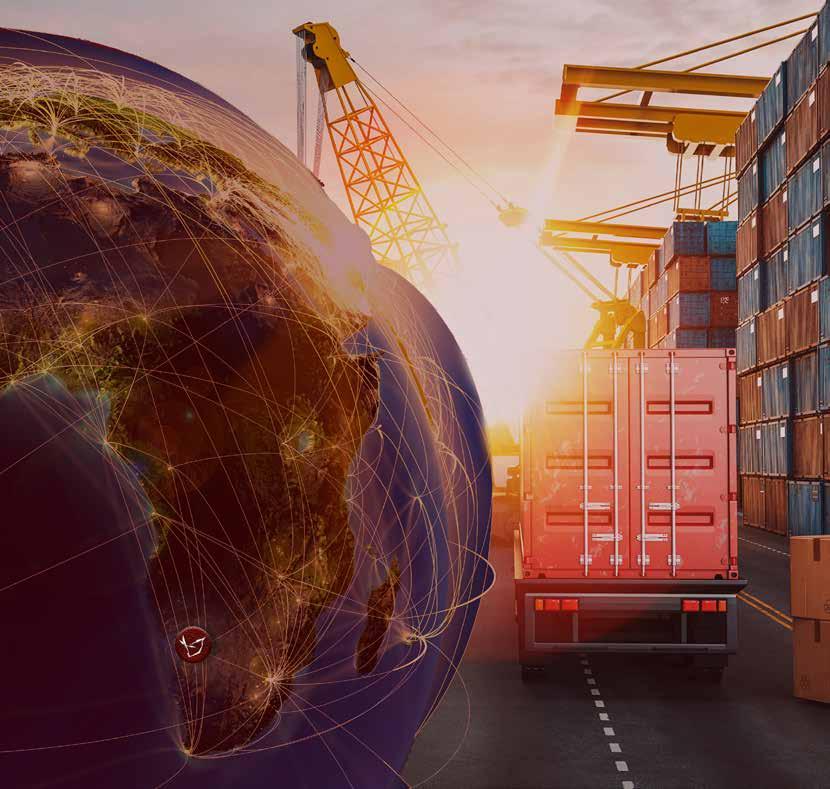

During the period under review, the WBCG Marketing and Communications department continued to promote and market the corridors, Namibia’s logistics and transport industry, and Namibia as the preferred Logistics Hub for Southern Africa.
This was accomplished on a national, regional, and international scale through a variety of media channels including social media, print, online publications, videos, and messaging platforms. In addition, concerted efforts have been made to engage key stakeholders in order to identify their needs and facilitate connections.
Stakeholder engagements have guided our communication and marketing activities as a key component of the WBCG’s business strategy. We have observed an incase in interactions, as a result we are now able to form new relationships and better align ourselves with the company’s goals.
We organized national and regional networking events to raise awareness of the Walvis Bay Corridors’ service offerings. These events included regional and international information sharing sessions, as well as local Logistics Hub forums. Information sessions were held in Zimbabwe, Botswana, the Democratic Republic of the Congo, and Zambia. The WBCG was also present at the Dubai Expo and Namibia Investment Conference in Dubai, as well as the Transport Evolution Mozambique.
We supported national stakeholders by ensuring the transportation industry’s presence at their events. Another successful collaboration with the Namibia German Centre of Logistics was the
13th Annual Transport and Logistics Workshop, which took place virtually in September 2021. This platform focuses on bridging the logistics industry’s gap between academia and industry by presenting practical case studies to increase participant engagement and improve the logistics learning process.
During the period under review, the WBCG launched the ‘Thank a Trucker’ campaign in collaboration with the National Road Safety Council and the Trans Kalahari Corridor Secretariat. The campaign aimed to raise truckers’ awareness of road safety and their importance in keeping the economy moving. Furthermore, it aimed to recognise truck drivers as frontline heroes during the Covid-19 pandemic. The campaign was carried out along all of the Walvis Bay Corridors, at major roadblocks (Katima Mulilo, Rundu, Gobabis, Swakopmund, Oshikango, and Keetmanshop) throughout the country. A total of 380 grateful truck drivers were reached.
The campaign events drew a lot of national attention and were well attended by representatives from the Ministry of Works and Transport, law enforcement, as well as local and regional authorities.
Partnerships are critical to our business model because they allow us to expand our reach. We continued to form strategic alliances in order to strengthen our role as a trade and transportation facilitator. Extending our network connections has allowed us to carefully select the events and partnerships that provide the most value to our stakeholders while also providing them with the opportunity to meet new clients. These collaborations bear fruit: as new audiences hear our message, and new opportunities for our members emerge.
Although the WBCG is recognized as one of the best corridor management institutions in Africa and has a strong brand presence in the industry, there is still a need to increase our efforts in raising more awareness on our role.

The WBCG maintains positive relationships with Namibian, regional, and international media. During the year under review, we focused on expanding our contacts with media organisations in all relevant markets in order to broaden our communication channels. Several advertorials were published in national, regional, and international transport and trade publications, such as the Freight and Trading Weekly (FTW), the Namibia Trade Directory, and other local and international publications. One of the key achievements during the period under review, was the development of the WBCG Corporate Identity, which serves as a guideline to ensure that our brand, image and messaging are consistent both internally and externally. As recognition of our brand continues to grow and interest in the route increases, we push forward by developing marketing and promotion campaigns which effectively communicate the brand’s unique value proposition
Our digital publications and online presence broaden our global reach. We continued to publish the eCorridor, our online newsletter which provides
updates on key developments and accomplishments as well as allows us to highlight the various activities of the WBCG, our members, and partners.
The WBCG’s social media presence is prosperous. The Facebook and LinkedIn accounts attract new followers on a daily basis and continue to grow in popularity. With regular updates and engagements, we can create awareness and communicate to the youth via Facebook about the future of logistics in Namibia, as well as the global business community through our LinkedIn presence. We have also created a Twitter account to expand our online presence. These platforms are used for post news, upcoming events, advertisements, job openings, and photo uploads
In the past year, we have steadily expanded our network in order to broaden our reach and expand our regional and global footprint. We are constantly on the lookout for new and innovative ways to disseminate industry information to local, regional, and global markets, and will continuously strive to build and sustain a strong brand in the best possible ways.
In our operational domain, we will continue to seek and implement new methods to raise awareness of the Walvis Bay Corridors and to establish the WBCG as the preferred provider of transport and logistics solutions.
for the period 1 April 2021 to 31 March 2022


The Brazilian government beliefs that a balanced existence is supported in a large portion by the economy and health of its citizens. In view of this, the government, during the period under review, worked on an equation that was on the one hand, to keep industry producing, and on the other hand, to maintain a high level of safety and security pertaining to Covid-19 protocols, to ensure that there were no imbalances. As a result of this strategy, Brazil emerged as the country with the highest success rates per capita in both the economy and health.
The Covid-19 pandemic greatly impacted Brazilian exports in 2021, and the economy, resulting in the GDP dropping by -4,1%. However, by the end of the 2021 the Brazilian economy was well on its way to recovery forecasting a +5% GDP growth. According to the economic growth and production indicators that have become established as true, Brazil emerged from the recession at the end of 2021 as a result of the significant increase in commodity prices. Brazil’s high productivity and high levels of production gave the nation a significant advantage, resulting in growth of 0.5% out of a total of 4.6% for 2021.
Despite the confirmed fall in the purchasing power in Southern Africa, where durable goods had a decrease in export orders,
due to restrictions imposed by Zambia on Brazilian poultry and the wide spread of avian flu in Asia, Europe, and South Africa. Brazil remained completely safe and free from the flu as a result of new safety protocols implemented in 2018. The new steps are making sure that Brazilian products are once again imported through the Port of Walvis Bay, especially by Zambia, which had a significant amount of import volumes from Brazil in the most recent quarter, in order to stabilize its stock. We predict a rising demand for imports if the financial ability to purchase of DRC, Zambia, Namibia, Botswana, Malawi, and South Africa remains sustainable, as there is tremendous concern about maintaining the food chain of these countries supplied.
We have been studying Ammonium Nitrate closely since 2017, and engaged companies in South America, who are interested in developing the potential of this market via Namibia. Our efforts were fruitful, as the first 3000 load of ammonium nitrate was successfully exported via the Port of Walvis Bay in May 2021, despite competition from competing ports in South Africa, Angola and Tanzania. We are also in discussions with chemical producing companies in Brazil and South America, giving them full support and presenting Namibia’s potential to industrialise the company’s processes to create a logistical and industrial hub to serve southern African mining companies in phase 1 and
2. The concept has been well received by the companies engaged and Namport, in which we have discussed an initial post pandemic operations of 8000 tons per month, 3000 tons for the Port of Lüderitz and 5000 tons for the Port of Walvis Bay, ensuring more volumes for Namibia.
A Brazilian break bulk cargo company Marcon, began a project in March 2021 that foresaw the absurd rise in container prices that would result from Covid-19 in China, and worsened by the blockage of the Suez channel. As the situation deteriorated, our office in Brazil reported that the demand for break bulk cargo would increase. That’s exactly what happened, and the break bulk cargo company sent its first ship loaded with the cargo. We established contact with this company and presented all the facilities we have to offer with Namibia’s logistical infrastructure. The logistic operator was unaware of Namibia’s strategic location, so we took advantage of the situation by giving a comprehensive presentation on Namibia’s multimodal logistic services, including from Lüderitz to South Africa through sea/ rail/road, and from Walvis Bay via sea/rail/ road. Our presentation was well received and generated interest in potential exports of food items, agricultural equipment, and buses via the Port of Walvis Bay, to Angola and the DRC.
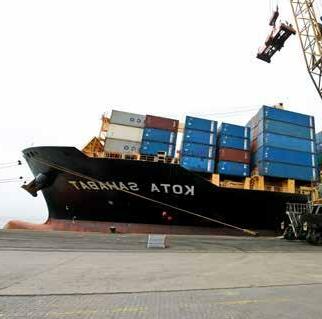
We introduced to the Brazilian logistic operators how an integration with its customers that operate with vehicles, agricultural machines, commodities such as sugar, maize meal, and other food products, could have strategic importance unloading in Namibia. This is in view of the ease of direct access to its break bulk ships, operating in the ports of Walvis Bay
and Lüderitz, and interconnecting with Angola by rail, with an easy access to the Katanga region in the DRC and also feeder to the port of Matadi to serve the Kinshasa region, which was very well received by the Board of the company that is studying the project.
The poultry companies, large Brazilian exporters of chicken and its products, has focused much of its commercial attention on Namibia, Zambia, Botswana and DRC, where it has been concentrating a lot of its efforts in direct negotiations with importers from these countries due to their strong financial capacity to hold good win-win negotiations, in order to support the regional demand. The ability to supply the Southern African market through these companies is an enabler to deliver these products at the highest cost efficiency, reduce average costs to the end consumer, and make food more accessible to all layers of the population within the African continent. This is why we have been striving to create more awareness about Namibia’s logistical infrastructure complex, as a facilitator for the operations of these companies, which is increasingly becoming a greater reality.
Today for shipping companies, the daily cost of operating a vessel has a major impact on the total combined cost of a container that generates ocean freight, so we see that shipping companies have had a greater difficulty in offering a more attractive ocean freight from Brazil to Namibia via the Port of Walvis Bay. In view of this situation, where we do not have unloading on weekends, holidays, at night and on foggy days, which ends up increasing the number of hours stopped by the ship at the port, and making the operation more expensive and directly reflecting on competitiveness from our Port for reasons of price and delay in releasing the vessel to continue its journey.
We have a great opportunity ahead because the world’s largest producers of cold chain food are in Brazil with whom we have direct contact and we have the shortest distance to the ports of Walvis Bay and Lüderitz. It is crucial that we connect to these industries and are closer to the importers from all over Southern Africa through the WBCG offices in Namibia, Zambia, the Democratic Republic of the Congo, and South Africa. In doing so, we will have a comprehensive solution that will meet both the needs of the importers and exporters for high-quality and costeffective products and provide them with an even greater benefit.
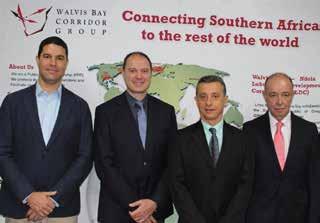
The direct call will be a consequence of a mutual effort, as it depends both on Brazilian exports that leave Brazilian ports, and on exports that leave Namibia bound for Brazil, as today we have an excess of empty containers returning to Brazil,
which impacts a lot on the average cost of sea freight, as the Brazilian exporter must pay for the freight to Walvis Bay and back for the empty container. As Brazil is the largest Hake importer in the world, a great solution to have the direct call faster would be to start direct exports of this fish to Brazil, which, in addition to making a lot of sense, would be a natural way to implement the direct call.
The significance of Namibia’s logistics, which includes the ports of Walvis Bay and Lüderitz, the connecting arteries that are its corridors, and the railway network, as well as the safety and reliability of its operators and service providers, is undeniable. Namibia thus gains logical and practical prominence. Furthermore, there is a growing demand for products produced by the massive industrial park in Brazil and South America from Namibia and its neighboring countries. As a result, in order to increase our competitiveness, we must work internally to improve the productivity and cost/benefit of integrated transportation. Whereas the final price of any product is heavily influenced by logistics costs, whether they are higher or lower, and it is a global trend to seek efficiency, this will be crucial for us to be successful in our commercial actions.
DRC’s economy remains very dependent on the mining sector, subject to the vagaries of international prices and is in a fragile situation. However, the growth outlook is more favourable for this year:
• 95% of total exports are minerals
• More than 40% of it is destined for China
• Projected economic growth for 2022 expected to increase by 6.2%
• 40% increase in trade volume on the WBNLDC going from 174000MT to 243000Mt
• Demand in cobat increased by 80% while demand in copper increased by 40%
• KAMOA MINING has started production and is set to overtake the biggest copper producer.
The increased trade volume on the Walvis Corridors is mainly attributed to the increased awareness, constant promotion and more visibility of the WBCG on the DRC market.

This trend resulted in direct consequence on our corridor such as:
• Increased south bound cargo availability from DRC;
• More sulphur import from Walvis Bay;
• Shortage of available transporters on the corridors;
• New customers;
• More DRC/Namibia engagements on government level as well as in the private sector.
• Record- breaking congestion at Kasumbalesa border post
Our activities have been focused on the importation of vehicles and machinery, sulphur, fuel and FMCG to increase northbound cargo and balance with return cargo. We managed to attract CFAO MOTORS and consolidate the business with SMT VOLVO, BRALIMA, BRASSIMBA, LIBERTY MA MAISON, JAMBO GROUP, HYPER PSARO and others. The Mining companies have also been responding positively to our engagements and considering the possibility of increasing exports through Walvis Bay.
Lignes Maritimes Congolaises (LMC) is also jumping on board as a new transporter on our corridors to offer their haulage services for road transport from Walvis Bay to Kolwezi and sea freight from Walvis Bay to Matadi.
We are continuously engaging other transport company to consider joining our corridors and increase the trade volume towards Walvis Bay. Our aim is to have the capacity to move yearly 300.000Mt for the DRC market by 2023.
As we are also expecting to successful attract more imports of bulk fertilizer through Walvis Bay to the Haut-Katanga and Lualaba provinces and hopefully extend our offer to the rest of DRC.
• Frequent congestions at Kasumbalesa border post.
• Shortage of transporters on our corridor is becoming a major challenge as the volumes to be transported from/to DRC increases.
• Namibian companies (transporters, clearing agencies, etc) are not visible on DRC market. It is important that they approach DRC business community to offer their services directly to the customers.
• The lack of a Namibian consulate in Lubumbashi makes it difficult to invite DRC business community to visit Namibia and have business engagements with Namibian companies.

• Advocate for the Kolwezi – Solwezi road project and new border post to be prioritized in order to smoothen the trade and shorten the distance from Walvis Bay to Kolwezi.
• The extension of the railway to Katima Mulilo will help Namibia offer competitive import and export solutions for the increasing volume on our corridor.
• Attract new transporters on our corridor that can take up the available
cargo at Walvis Bay with incentives to do business on our corridors as Walvis Bay is positioning itself as the fastest trade route.
• As DRC and Zambia would like to start manufacturing batteries in the region, therefore Namibia should develop complimentary project to support this initiative and position itself as the best trade route for West African countries to benefit from the batteries produced in the region.
• Pushing for Namibian logistics companies to open branches or representations in Lubumbashi and Kolwezi for better exposure or to enter into partnerships with local logistics companies and offer better services.
• We need to take advantage of the Namibian industrial land between Kasumbalesa and Lubumbashi to create incentive for trade on our corridor by developing storage and clearing facilities for cargo transiting through Namibia.
• We need a Namibian consulate in Lubumbashi as we create more visibility for Namibia, the business community needs to have easily access to visa and further information about Namibia.
South Africa benefitted substantially from the robust global economic recovery in 2021. The steep rise in world trade volumes lifted demand for a wide variety of goods, extending well beyond mining and mineral products. Total merchandise exports increased with exports of mining products and manufactured exports increased.
The South African economy is expected to remain on a steady recovery path, although a substantial growth moderation is projected for 2022. The robust rates of growth anticipated for world production, import demand and trade volumes in 2022 should continue supporting exportoriented businesses across the domestic mining, manufacturing and agriculture sectors. They should also provide market development opportunities for local and regional companies aiming to expand companies across the world have been realising the importance of diversifying their sources of supply.
Ongoing supply/value chain disruptions caused by production constraints as well as transport and logistics bottlenecks have resulted in serious shortages of input materials, intermediate products and consumer goods in recent times. Such developments should translate into increased global investment activity going forward to diversify centres of manufacturing production and enhance supply chain resilience. Some of this investment could potentially be attracted
into South Africa and the rest of the continent.
Constrained finances will continue limiting infrastructure investment by the public sector, highlighting the importance of securing the financial standing of stateowned enterprises. Nevertheless, private sector participation is likely to contribute to the progressive implementation of Investment opportunities will arise in the renewable energy, water, telecommunications, as well as transport and logistics arenas, as an integral part of the structural reforms for the SA economy
The implementation of master plans is gathering momentum in industries such as poultry, clothing and textiles, automotive, agriculture and agroprocessing, and sugar. This is resulting in visible performance improvements in their operating environment as well as in investment opportunities going forward.
A significant increase in investment activity is anticipated in several emerging industries, particularly those focusing on the greening and decarbonisation of the economy. These include investments in the electric vehicles and green hydrogen industries, as well as in mining industry activity in strategic minerals that are crucial for clean energy and a greener economy (such as platinum, vanadium, cobalt, copper, manganese and lithium).

Contributing factors included the violent unrests, looting and destruction of property in parts of KwaZulu-Natal and Gauteng in July 2021, congestion at Durban port, load-shedding, industrial action in the steel and engineering sectors, and ongoing supply-chain disruptions which also affected the automotive and other industries). Cargo could not be moved while the N3 was closed for eight days during July’s riots in KwaZulu-Natal and Gauteng.
About 250 trucks were destroyed during the protests, amounting to millions in loss in assets and cargo, while operators suffered loss of income due to their inability to operate.
The project for the import of the Bulk Sulphur was facilitated and secured and has shipped approximately 50000t in 2021. We recently received a bulk Vessel of 10000t in February 2022. The highlight of this project is that the South Africa based customer normally utilized the South Africa Ports for all imports of Sulphur shipments and with our efforts, hard work & dedication we have managed to successfully divert these volumes via the port of Walvis Bay which is for the Zambia & DRC market. This also creates a potential opportunity for an import/export balance on the corridor. The customer is greatly satisfied with the excellent services and efficiency of the WBCG and Namport.
The Trans-Kalahari Corridor (TKC) linking the port of Walvis Bay for Botswana and Zimbabwe Market has gained high momentum and this is also due to the result of aggressive business development initiatives and marketing. Bulk imports
and exports for commodities such as copper, coal, sugar, fertilizer and fuel are major commodities that have increased the performance on the TransKalahari Corridor. Copper mines based in Toteng Area, Botswana have complemented the road infrastructure to the port of Walvis Bay and is shorter in distance of approximately 600km to the port of Walvis Bay opposed to port of Durban. The Walvis Bay Corridor Group has facilitated a solution together with Namport for break bulk copper concentrates and coal that has been exported via the port of Walvis Bay. The mines are very impressed with the infrastructure and the dwell time of approximately 30 minutes at the Mamuno/ Trans-Kalahari border.
Manganese mine exporters prefer the efficiency of the Trans-Oranje Corridor (TOC) and the port of Lüderitz. We can certainly see increase of volumes on the corridor once the trans-shipment hub/ common user facility will be developed to handle higher tonnage of Manganese. Manganese Mines also will commit further volumes as the benefits of the port of Luderitz such as no congestion is extremely crucial for the export of Manganese.
We are working with all the logistics members to ensure this project for the Transshipment Hub will be achieved.
Namport together with the WBCG have facilitated and fixed a supply chain solution for one of the largest sugar importers based in South Africa who has a partnership with the one of the largest Sugar producers in Brazil. This is a huge milestone for the port of Walvis Bay and the economy of Namibia. The sugar vessel has been offloaded middle March 2022.
This is a perfect alignment for SADC from the port of Walvis Bay as this break bulk sugar will also be stored at the Namport Warehouses and Botswana Dry Depot which will distributed to Botswana and Zimbabwe markets. Medium term we can also see sugar been transported to Lubumbashi DRC.Next vessel provisionally shipped Middle May of 15000t break Bulk Sugar for Botswana and Zimbabwe via the port of Walvis Bay from Paranaque port, Brazil.
Globally the shipping industry is experiencing a complete change. To keep abreast many shipping lines have decided to form joint ventures and in some instances form mergers. Volumes have started to fluctuate also due to FREIGHT RATES for both import/export freight almost triple with some shipping lines. There has been imbalances and shortages of 20FT containers – thus forcing customer to utilise 40FT containers (hence the high freight rate).
The throughput to both South Africa and Botswana seemed have sustained their growth/volumes especially due to bulk cargo, however the volumes for Zimbabwe have dropped due to the freight and road transport costs.
Due to the container issues and some shipping lines omitting the port of Walvis Bay, we need to facilitate and need to market Bulk cargo imports/exports for the various markets and our various corridors linking the ports of Walvis Bay and Lüderitz. Some of these commodities for example are coal, copper, sugar, salt,
chemicals and also vehicles that can ship on Ro-Ro vessels. We need to work with charter vessels & shipping lines that have ocean freight schedules that can handle Bulk cargo for import/export via the Namibia ports and all the relevant logistics and transport members that can package a competitive supply chain solution. Warehousing and Storage space which is crucial to the supply chain also needs to be offered at competitive rates.
The WBCG South African office has established good working relationships with key strategic supply chain operators, shipping lines, manufacturers, commodity traders and government agencies. Relationship building, networking and awareness creation is a major focus for the WBCG office in South Africa to maintain a close working relationship with clients and support the members of the Walvis Bay Corridor Group and support the various Business Development offices for the Walvis Bay Corridor Group based in Namibia, Zambia, Democratic Republic of Congo (DRC) & Brazil.
Communication is key to successful Business Development to ensure we facilitate logistics and supply chain solution from start to finish for all corridors linking the Namibia ports.

The report focuses on the highlights of few major developments and challenges in the Zambian transport and logistics sector. Furthermore, how other factors impacted on the trade environment and corridor volume performance. Factors such as the aftermath of the Covid-19 pandemic causing global container shortages and shipping lines skipping the Port of Walvis Bay.
Conversely, the successful implementation of export of copper as break bulk by NAMPORT and the setting up of the Sulphur facility in Walvis Bay has stabilised the corridor volumes. Furthermore, WBCG clinched a fuel importation deal with the Petroleum Transporters Association of Zambia (PTAZ) for the fuel to be procured via the Port of Walvis Bay into Zambia. Also, to mention the contribution of the new transport companies that have commenced the trading on our corridor.

The failed bilateral agreement between Zambia and Mozambique on locking Zambia’s fuel imports to the port of Beira opened a huge opportunity for the port of Walvis Bay to attract some of Zambia’s fuel imports to WVB. Trial runs for movement of fuel which commenced on 27/02/21 by PTAZ from Walvis Bay to Zambia
turned out to be a success, was followed immediately by a huge shift of fuel imports into Zambia from Beira to the port of Walvis Bay. Currently this project is been pushed between Petroleum transporters association of Zambia and EGEN-Namibia.
The frequent outbreak of bird flu in Europe was having a negative effect on the importation of poultry products from European countries which in turn reduces import volumes for frozen products by Zambian companies via the port of Walvis Bay on two fronts. First, Namibian authorities could not allow transit of any poultry and meat products from EU while Zambia enforced a total ban of poultry products imports from EU.
Walvis Bay Corridor Road freight fees remains high compared to the road freight fees on Dar corridor. Feedback from some clients both in Lusaka and Copperbelt indicated that on average the Dar corridor road freight fees are around $ 4,200 whereas on the Walvis Bay Corridor the road freight fees are around $ 5,000+ for delivery of a truckload. The perception that our corridor is expensive continues to exists among key stakeholders in Zambia.
The skipping of the port of Walvis Bay by some shipping lines in the recent past continues to cause delays in cargo movement into and out of the port of Walvis Bay.
This forced some Zambian importers and exporters to re-route some of their cargo to other ports i.e., Dar and Durban more especially copper exports. This challenge threatens even companies like new transport companies which had intentions to expand their fleet of trucks from their current 50 trucks to over 100 trucks on our corridor last year as well as some chemicals importers who were prospecting to import 100,000MT of mining chemicals from India via Walvis Bay into Zambia. It is the hope of the Zambian business community that this situation corrects itself sooner than later for the betterment of the recovery of the lost opportunities for our corridor.
Industrial dishormony in the mining sector, the first quarter of 2021 saw a strained relationships between government and some major mining companies. Government had indicated that they will replace value added tax with sales tax, this lead to mining companies scaling down on their production as they opposed the proposed changes. As a result the projected annual output for copper which was project at 1.2 million tons could not be met instead only 920,000 MT was produced in 2020 while copper production dropped further to 820,000 MT in 2021
Copper exports from Zambia via WVB reduced during the course of 2021 because the port of Beira continues to win more business from Zambia due to shorter distance and the improvements the Port Authority of Beira has undertaken as well as increased shipping lines calling at the port of Beira in the recent past.
In order to recoup the lost corridor volumes, there will be need to increase the quantity
and frequency of bulk copper exports via WVB and an aggressive marketing plan to publish this new development to most mining companies in Zambia both new and the old. More efforts will be channelled in attracting commodities from other sectors of the economy like the household goods, electronic products and various types of spares. Activities to attract and bring on board some of the major Zambian fertilizer importers to the Port of Walvis Bay corridor were increased by engaging key stakeholder serving the sector.
Marketing programs and projects to increase visibility of the corridor were expanded. While WBCG is registered under section 21 (not for profit) time is now to start considering sponsored tours for key stakeholders to visit the port from Zambia i.e., Industrial Development Corporation, Zambia development Agency, Zambia Association of Manufacturers, Oil Marketing Association, Permanent Secretaries from the ministry of Commence & Trade, Ministry of Agriculture and representatives of selected mines.
Efforts will be channelled on helping the new entrants and prospecting client to get established and expand their operations on our corridor like transporting companies and other forwarding companies.

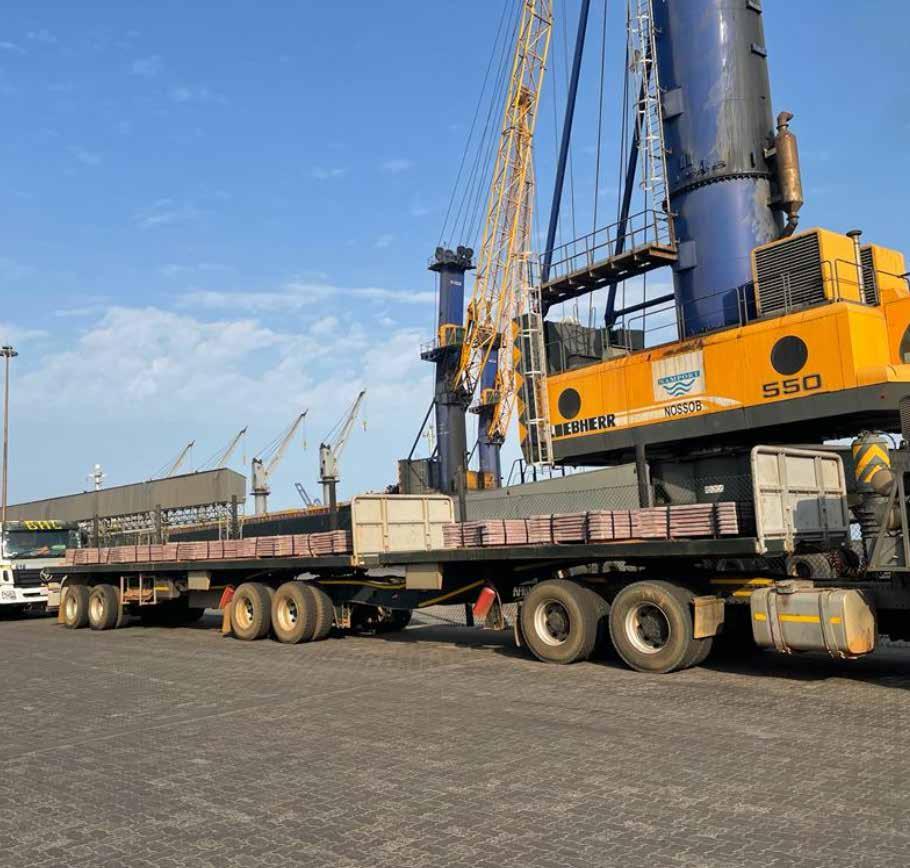
The Walvis Bay-Ndola-Lubumbashi Development Corridor interim secretariat was established on 5th March 2010 in Livingstone Zambia, following the signing of the tripartite trade facilitation agreement by the three member states - Democratic Republic of Congo, Namibia and Zambia.
Since its establishment the Walvis Bay Corridor Group has coordinated its activities at its headquarters in the Republic of Namibia and has also hosted the interim secretariat at its Lusaka office in the Republic of Zambia.
Through the terms of reference set out in the tripartite agreement, the corridor committee has been strategically collaborating with the public and private sector in the three member states in making interventions aimed at resolving the various encumbrances affecting the smooth flow of goods, people, and services along the corridor.
This strategic partnership is anchored on the values of soft and hard infrastructure development, fostering trade efficiencies, transport and logistics solutions aimed at reducing transaction costs, and enhancing regional value and supply chains.
ZAMBIA - BOTSWANA KAZUNGULA ROADRAIL BRIDGE AND ONE-STOP-BORDER POST FACILITY OFFICIALLY OPENED
The 929 meters Kazungula Bridge and OSBP facility was officially commissioned on 10th May 2021. The USD 259 million new road and rail bridge is expected to ease access to international markets through connectivity with major seaports, more so that pre-registration and preclearance of bills of entry are mandatory five days before goods arrive at the border.
The project speaks to infrastructure deficit along regional corridors and is anticipated to enhance operational and trade efficiencies along the North - South corridor as well as regional integration.
Freight and passengers transit times are projected to be significantly reduced owing to improved processing efficiencies and border management operations arising from the OSBP border facilities.
The new infrastructure is also projected to enhance risk management processes and revenue yields by both customs administrations. The SADC-Corridor Trip Monitoring System (CTMS) was also piloted and launched at the OSBP facility. It is also anticipated that regional economic development would be boosted through tourism in the Kavango-Zambezi TransFrontier Conservation Area (KAZA-TFCA) (Zambia, Zimbabwe, Botswana, Namibia and Angola).
The spectacular multi-million dollar investment would now need a dedicated hardworking cadre of skilled officials with

ositive attitudes from both Zambia and Botswana to be responsive to this bankable regional infrastructure investment.
The Zambia and Namibia bilateral one stop border post meeting was held at Katima Mulilo in the Republic of Namibia between 14-16 June 2021. The meeting sought to enhance bilateral discussions on piloting and implementation of the One Stop Border Post (OSBP) at Katima Mulilo border post, as well as revise and update the roadmap thereof.
Fruitful in-depth discussions on One Stop Border Post piloting and implementation were anchored on: (1) finalization of OSBP bilateral agreement, (2) draft operational manual for Katima OSBP (3) draft terms of reference, and (4) Date and venue of the third OSBP bilateral meeting.
The bilateral road map for guidance and implementation of the OSBP project was revised and re - drafted.
The key takeaway for WBCG and WBNLDC is to maintain robust and effective partnerships with both governments in lobbying for and mobilizing financial resources for the OSBP project. WBCG and WBNLDC would also offer relevant support in the development of the OSBP procedural manual, capacitation and training of various border operatives (capacity building), sensitization, change management, institutional reforms and readiness necessary for the implementation of the OSBP project.
The Republic of Zambia would host the next OSBP bilateral meeting in Livingstone. The next meeting would include a guided tour of the Kazungula One-Stop-Border Post facility to appreciate emergent operational and governance issues, as well as take stock of lessons learnt in the implementation process to inform the latter project at Katima Mulilo.
Zambia has now jointly developed four operating one stop border posts namely: Chirundu (Zambia/Zimbabwe border),

Nakonde/Tunduma (Zambia/Tanzania border), Kazungula (Zambia/Botswana border), and the Mwami/Mchinji OSBP (Zambia/ Malawi border).
STATUTORY INSTRUMENT NO.51 OF 2021PUBLIC SERVICE VEHICLES RESTRICTION ON NIGHT DRIVING AMENDMENT REGULATION
The regulation on public service vehicles restriction on night driving in Zambia was amended on 14th May 2021 from (21h00 to 05h00); to (22h00 to 04h00). Therefore transporters and other passenger vehicle operators ought to apply with the Road Transport and Safety Agency (RTSA) to be granted a permit to operate from 22h00 to 04h00, in special circumstances. In retrospect, it would be imperative for the Zambian government to prioritize repair of the deteriorated sections of road infrastructure along major transport corridors before executing such a regulation to enhance road safety and reduce road traffic accidents on Zambian roads.
The Ministry of Works and Transport, in collaboration with the SADC secretariat - Transit Transport and Trade Facilitation Program (SADC-TTTFP), hosted this virtual Industry consultative stakeholder meeting in July 2021 on Corridor Trip Monitoring System (CTMS) project.
The consultative stakeholder engagement was part of the preparations - for operationalization of the project. CTMS is one of the interventions to facilitate the continuation of trade flows, and a regulatory framework that reduces the spread of Covid-19; monitors truck drivers’ health and wellness in road transport sector.
The system provides for mutual recognition of Covid-19 test results for truck drivers and can also be used to manage domestic transport operations to ensure safe and sustainable domestic supply-chain operations (electronic cargo tracking system).
MINISTERIAL DECREE NO. 0002 DATED 29TH JULY 2021 - ON THE CROSS-BORDER TRANSPORTATION OF GOODS REGULATIONS - DEMOCRATIC REPUBLIC OF CONGO
Through its Ministry of Transport and Communications - Democratic Republic of Congo enacted a ministerial decree No.0002 of 29th July 2021. According to article 4 of the decree, it is strictly prohibited for a vehicle not registered in the Democratic Republic of Congo, to load goods, in this case, mining products, from the national territory.
In the event of violation of article 4, goods are immediately unloaded at the shipper’s or transporter’s risk. This decree discriminates against foreign transporters and is at variance with the provisions of the SADC protocol on trade, transport, and meteorology. In this perspective, the head of state in DRC urged the Ministers of Transport to revise the decree in order to bring some potential modifications.
The SADC secretariat’s legal department also activated interventions with the DRC government as the decree was clearly at variance with signed and ratified regional and continental trade agreements that DRC was party to.
NAMIBIA AND ZAMBIA CO-CHAIRS CONSULTATIVE CLUSTER MEETING AIMED AT PROMOTING TRADE, TRANSPORT AND LOGISTICS IN SOUTHERN AFRICA, LUSAKA ZAMBIA
The Namibia and Zambia co-chairs
consultative cluster meeting was held in Lusaka Zambia on 14th September 2021. The objective of the consultative meeting was to facilitate policy dialogue and information sharing on prevailing trade, transport and logistics matters between the two countries and provide mitigating measures thereof.

The meeting was also aimed at promoting bilateral cooperation and the corridor development approach in fostering social, and economic transformation between the two countries. Some of the recurrent challenges affecting trade along the corridor were highlighted in a matrix and are already receiving active attention.
The main issues discussed were: the deplorable, deteriorated SeshekeKazungula and Kaoma-Kasempa roads, ratification of the WBNLDC tripartite agreement, cumbersome Zambia police 25 checkpoints and road blocks along the corridor, requirements for fire extinguishers and first aid boxes for truck drivers, statutory instrument No.74, the domestic or inland tollgates amendment regulations, council levies, limitations in the issuance of export permits for maize bran and other agricultural commodities
on the Zambia electronic single window platform, the exorbitant immigration transit fees for truck drivers, temporal export ban from Zambia of day old chicks by the Ministry of Fish and Livestock.
One of the persistent challenges that transporters in the region have been facing along the corridors in Zambia were the cumbersome police checkpoints and roadblocks that were inimical to trade, and transport logistics efficiencies. The WBNLDC, and other stakeholders in Zambia had been engaging the Zambia Police Command on numerous ocassions.
Consequently, in September 2021, the Zambia Police suspended the road traffic checkpoints. Thus the Inspector General of Police directed all provincial deputy police commissioners to ensure that Zambia Police Officers under their charge take heed to the government directive on suspension of snap road traffic police checkpoints across Zambia. Only recognized security checkpoints which operate on a 24-hour basis would remain operational.
Along our corridor, the security checkpoints include: Southern Province (3) i.e., (Livingstone weighbridge, Nakatindi road ZAWA gate, and 10 miles Mazabuka), Western Province (3) i.e, (KasayaLivingstone road, Sioma bridge and Kalabo road), Lusaka Province (3) i.e., (Kafue bridge, Makeni turnoff along Mumbwa road, and Kabangwe area), Central Province (7) i.e., (Manyumbi/Luanshimba, Chisamba, Kapiri-Mposhi great north road, Kapiri-Mposhi Ndola road, Ndabala, Pensulo, and Nangoma), and Copperbelt province (8) i.e., (Kafulafuta, LuanshyaKitwe-Ndola junction, Kafue bridge, Sakanya, Mokambo, Sabina, Solwezi junction, and Kasumbalesa) traffic police would, however, continue conducting highway motorized patrols, and traffic management duties whenever need arose.
In October 2021, incidents of assault on foreign truck drivers by criminal gangs in Katima Mulilo and Rundu, Namibia were reported along the corridor. WBCG collaborated with the Namibian Police through the Regional Commanders, and other community leaders. After successful investigations some culprits were arrested and the situation normalized. WBCG would continue with road safety awareness programs, route assessments as well as community awareness activities aimed at maintaining the safety and security niche that the Walvis Bay transport and economic corridors are renowned for.
In line with the Immigration and
Deportation General (Amendment Regulations) of 2000, the Ministry of Home Affairs - Department of Immigration in the Republic of Zambia revised all immigration permit fees including transit permits for truck drivers, with effect from 1st January 2020. The fees were pegged at the same amount regardless of the sector whether private, non-governmental, or government entities, as was the case previously.
The statutory fees were increased by more than 100%, and transit permit issuance was pegged at ZMK 9,000, and transit permit renewal was pegged at ZMK 11,250. However, there has been an outcry from many foreign transporters and truck drivers as this increment impacted the cost of doing business along the corridors in Zambia. Continuous engagement with the Immigration Department in Zambia is being executed to find common ground.
As we strive for the elimination of restrictive immigration visa regimes that constrain cross-border movement of truck drivers in the corridor states, we also enhance our advocacy efforts towards the slow pace of signature and ratification of the African Continental Free Trade Area - Protocol on Free Movement of Persons as well as the African Passport.
IMPROVEMENT PROJECT (TIIP) - FEASIBILITY STUDIES FOR THE TRANS-ZAMBEZI RAILWAY EXTENSION (GROOTFONTEIN - RUNDUKATIMA MULILO)
The Government of the Republic of Namibia (GRN) is implementing the Transport Infrastructure Improvement Project (TIIP), which is co-financed with the African Development Bank (AfDB).
The project is part of the GRN’s strategic
plan to position the Republic of Namibia into a regional transport and logistics hub in Southern Africa, and includes interventions in the road and rail transport sub-sectors which are of mutual benefit to both Namibia and Zambia, as well as the entire SADC region. The rail component includes the following sub components: The upgrading of the 210km Rail section between Walvis Bay port and Kranzberg to SADC specifications (18.5 ton /axle load). Consultancy services for feasibility studies of the Trans-Zambezi-Railway extension project (Grootfontein-RunduKatima Mulilo), and market analysis for rail operations study.
Therefore, the Ministry of Works and Transport contracted MR Technofin, a Canadian consultancy firm to execute the assignment. The objective of the consultancy services for the feasibility studies for the Trans-Zambezi Railway extension is to assess the technical and financial viability of connecting the Walvis Bay port to the rail networks in Zambia, Botswana and Angola. Thus between 29th and 30th September 2021, the consultant together with Ministry of Works and Transport conducted a field mission in Lusaka, Zambia. We facilitated stakeholder engagements and consultations in collaboration with the Ministry of Transport and Logistics.
The support we rendered was also extended to the Republic of Botswana field mission in collaboration with the Ministry of Transport and Communications as well as the Trans-Kalahari corridor secretariat. The technical team also engaged the government authorities and other relevant stakeholders on how the four countries could collaborate and
develop the proposed rail links.
REPUBLIC OF NAMIBIA BILATERAL TRADE MISSION TO THE REPUBLIC OF ZIMBABWE
The Namibia bilateral trade mission to Zimbabwe was conducted between 8th and 21st October 2021. The mission activities included information sessions in Harare, Hwange and Bulawayo, corridor assessments and border benchmarking on Biera corridor, North-South corridor, Plumtree, Forbes, Beitbridge, Victoria Falls, and Kazungula border posts.
Several business-to-business meetings with the private sector In Harare, Bulawayo, Hwange and Beitbridge were also conducted. The Namibia trade mission to Zimbabwe was a mult-sectoral public-private-partnership stakeholder undertaking that was led by Ambassador Nicklaas Kandjii the Namibia Ambassador to Zimbabwe.
REPUBLIC OF ZAMBIA - PUBLIC AND PRIVATE STAKEHOLDERS ENGAGEMENTS IN LUSAKA, NDOLA, KITWE, CHINGOLA, SOLWEZI AND KASUMBALESA
The WBCG in collaboration with the Ministry of Works and Transport conducted a cross section of public and private sector stakeholder engagements in the Republic of Zambia from 15th November 2021 to 3rd December 2021.
Aimed at promoting trade, business
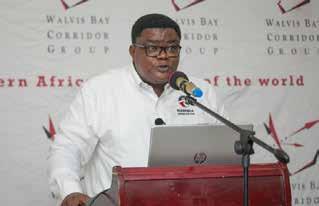
development, transport, and logistics facilitation as well as renewing institutional linkages and strategic partnerships, the mission was executed in Lusaka, Ndola, Kitwe, Chingola, Solwezi, and Kasumbalesa border post.
During the programme, it was clear that the road infrastructure between Lusaka and Ndola had further deteriorated due to the treacherous rumbling; bumpy waves that compromise road safety for truck drivers and other motorists as well.
Road traffic accidents had increased on this stretch. The high traffic volumes and congestion at Kasumbalesa could also be clearly seen as freight cargo from regional transport corridors converged there. The bustling informal market on the no-mans’ land of Kasumbalesa border, the “Bilanga”, was characterized by human powered non - motorized vessels, mainly modified bicycles, that could be seen hauling as much as five to ten tons of assorted general merchandise such as groceries, food stuffs and beverages, building materials, and agricultural products destined for the Democratic Republic of Congo on a single trip. Smuggling and under valuation of merchandise was rife at “Bilanga”, and rogue DRC agents collected arbitrary import and cross border charges thereof.
OFFICIAL LAUNCH - PILOTING OF THE CORRIDOR TRIP MONITORING SYSTEM (CTMS) IN THE REPUBLIC OF ZAMBIA - 26 NOVEMBER 2021 - CHIRUNDU ONE STOP BORDER POST
The SADC Tripartite Transport and Transit Facilitation Programme (TTTFP) in collaboration with the Zambian Ministry of Transport and Logistics officially launched Corridor Trip Monitoring System (CTMS) at Chirundu One-Stop-Border-Post in the Republic of Zambia on 26th November
2021. The Zambian government in collaboration with the SADC-TTTFP successfully installed CTMS equipment at eight border posts.
The CTMS is expected to reduce the extent of human interaction between frontline border operatives, drivers and their crews, as well as enhance corridor performance monitoring and surveillance.
The Corridor Trip Monitoring System installation Committee in the Republic of Namibia conducted stakeholder sensitization at all border posts where the system was installed. SADC secretariat offered training - capacity building for the system operators and border officials.
All motor vehicles, excluding trucks, tankers and other heavy-duty vehicles, transiting through Zambia as transit cargo by road, would be required to be transported on a motor vehicle carrier specifically designed to carry such vehicles effective 1st January 2022.
This requirement is in line with the Customs and Excise (goods in transit) rules, 2021, contained and listed in gazette notice number 124 of 2021, which includes other risky commodities such as groceries, alcoholic and non-alcoholic beverages among others.
The measure is a risk management intervention to curb transit fraud, and revenue losses to the Zambian government. The measure also seeks to also protect the transit bonds of clearing agents and freight forwarders whose business operations get disrupted due to outstanding transit transactions on the
customs Automated System for Customs Data (ASYCUDA) world system.
Further, the measure is also intended to enhance trade facilitation and the logistics sector through the reduction of associated risks on transit motor vehicles.
for enhanced service delivery;
• Provide appropriate solutions and recommendations that would inform policy decisions;
• Congestion and clearance delays;
THE WALVIS BAY CORRIDOR GROUP, THE MINISTRY OF WORKS AND TRANSPORT, AND WALVIS BAY-NDOLA-LUBUMBASHI DEVELOPMENT CORRIDOR - STAKEHOLDER ENGAGEMENTS IN ZAMBEZI REGIONKATIMA MULILO & NGOMA
The Walvis Bay Corridor Group in collaboration with the Ministry of Works and Transport, and the Walvis Bay - Ndola - Lubumbashi Development Corridor, held stakeholder engagements in the Zambezi region from 12th to 15th January 2022.
The missions commenced with follow up visits at Katima Mulilo and Ngoma border posts in order to appreciate the re-current operational challenges impacting the smooth flow of trade at the borders.
Several stakeholders’ engagements were held in the region, and a consultative stakeholders cluster meeting was held on Friday 14th January 2022 at Zambezi Vocational Training Center in Katima Mulilo.
• Provide a platform for various border agencies and stakeholders to take stock of their achievements, challenges, and operational omissions experienced at the border;
• Conduct stakeholder engagements aimed at finding permanent solutions to recurrent trade facilitation challenges at Katima Mulilo border post; Identify resource requirements
• Lack of parking space; ack of a physical inspection facility, lack of office space; Limited human resources, lack of security at ‘nomans’ land;
• Lack of presence at the border of agriculture and forestry officers for issuance of permits on various commodities, non-functioning generator for power back - up and business continuity;
• Poor internet connectivity and erratic scanner operations.
These challenges were incorporated into the Zambezi action plan that was developed during the stakeholders’ meeting, and are actively being addressed. Continuous follow-ups on action points are our pre-occupation.
The Zambezi Regional Council leadership, through their maintenance section addressed challenges regarding the stand-by generator set. The Zambezi Regional Police Commander’s office has also engaged counterparts and the leadership of the Erongo region for motor vehicles cleared at Walvis Bay port to be fully cleared with Namibia Police and Interpol as well.
The Zambezi Regional Police Commander’s office also engaged the Regional Manager at NamRA for secondment of Namibia Police officers for scanner operations at Katima Mulilo border post, to enhance
national security.
During the period under review, numerous complaints were received from Namibian transporters on the exorbitant transit permit fees charged by the Immigration Department of Zambia at Katima Mulilo border post, increasing the cost of doing business. Whereas, employment and investor permit fees, cross - border permits, and other visa fees were revised downward effective 1st January 2022; the transit permit fees for truck drivers remained the same at K9, 000 per year.
Namibian truck drivers, and other foreign truck drivers are disadvantaged when operating in Zambia, as the 90 days offered per year are not transferrable into the next calendar year. Continuous engagements with the Zambia Immigration Department are on-going as this regulation is at variance with the SADC Protocol on Transport, Communications and Meteorology, as well as the African Union Protocol on the free movement of persons in Africa, ZambiaNamibia Bilateral trade agreement, and the WBNLDC tripartite agreement.
2
NAMIBIA REVENUE AGENCY (NAMRA)PRE - CLEARANCE PROCEDURES AT KATIMA MULILO, TRANS - KALAHARI, ARIAMSVLEI, OSHIKANGO, AND NOORDOEWER BORDER POSTS
As part of interventions to identified recurrent challenges at Katima Mulilo border post (clearance delays and congestion), following our stakeholders engagements in the Zambezi region in January 2022, the Namibia Revenue Agency (NamRA) introduced preclearance as a trade facilitation tool to enhance trade efficiencies at Katima
Mulilo border, Trans-Kalahari, Ariamsvlei, Oshikango, and Noordoewer border posts.
This is a progressive trade facilitation initiative that speaks to World Trade Organization and World Customs Organization best practices. The introduction of pre-clearance as a trade facilitation tool by NamRA at these major border posts would reduce congestion and clearance delays as well as enhance regional trade and logistics efficiencies, integration and intra-African trade.
As we continue to monitor average standing times at Katima Mulilo, there is also need to conduct a time-release study to establish the numerous factors and challenges impacting productivity and efficiency in service delivery at the border post. Despite the implementation of pre-clearance by NamRA at Katima Mulilo border post, one of the key factors affecting processing efficiencies and causing congestion at the border is the lack of an efficient risk management and risk assessment system in the clearance of various high value commodities especially copper from Zambia and DRC in transit to Walvis Bay port.
Better and more efficient risk management and assessment techniques enable efficient delivery of targeted operational interventions and ultimately, trade facilitation, and service delivery.
- GROOTFONTEIN - RUNDU - KATIMA
MULILO - DRAFT FEASIBILITY STUDY REPORT PRESENTATION
In collaboration with the Ministry of Works and Transport, and the African Development Bank, the consultant for the feasibility study on the Trans-Zambezi
Railway Extension project-Grootfontein, Rundu to Katima Mulilo, Technofin of Canada made their preliminary presentation of the draft report on 17th February 2022.
The Ministry of Works and Transport and the African Development Bank were appreciative of the extensive work done by the consultants i.e. kick-off, final inception report and inception presentation, engineering working paper, travel demand report, field mission report, and draft feasibility report. The route length for the project is 772 kilometers and track length is 872.93 kilometers - Grootfontein to Katima Mulilo The total estimated cost of the project is a whooping USD2.26 Billion.
The project feasibility looked at commercial, economic, environmental, and legal aspects. The Trans-Kalahari to Walvis Bay route for future railway development on the Trans-Kalahari Corridor is about 1,500 kilometers.
THE TRIPARTITE MEETING FOR THE TECHNICAL COMMITTEE OF SENIOR OFFICIALS AND MINISTERS OF THE WALVIS BAY-NDOLA- LUBUMBASHI DEVELOPMENT CORRIDOR
The tripartite meeting for the technical committee of senior officials and Ministers of Transport of the Walvis Bay-NdolaLubumbashi Development Corridor was successfully held from 16th to 17th March 2022 at the Pullman Grand Karavia Hotel in Lubumbashi DRC.
THE SALIENT OBJECTIVES OF THE MEETING WERE TO:
• Review progress, challenges, and opportunities in the implementation and uniform application of the Walvis Bay-Ndola-Lubumbashi Development Corridor agreement as
was directed by the member states in March 2010.
• Provide a platform for policy dialogue for Member States and stakeholders to foster greater trade efficiencies.
• Identify resource requirements for the full implementation of the WBNLDC agreement.
• Propose appropriate recommendations to the Member States for full implementation of the WBNLDC agreement.
• To highlight recent developments in the member states and regional economic communities regarding trade facilitation matters along the corridor.
SOME OF THE KEY OUTCOMES OF THE MEETING WERE:
ESTABLISHMENT OF A PERMANENT SECRETARIAT AND SUSTAINABILITY FUNDING THEREOF
The Council of Ministers approved the recommendation by member states on the user pay principle funding mechanism to sustain the operations of the secretariat.
However, WBCG and WBNLDC were tasked to undertake a detailed analysis before the next technical meeting for consideration by the Council of Ministers on the rate of USD0.90 per ton as was proposed by DRC through its Ministerial Order No. 52 of 2017. There is need for thorough consultations with all key stakeholders Namport, Road Fund Administration, and Ministry of Works and Transport.
Further, the Council of Ministers decided that Namibia should host the headquarters of the permanent secretariat; and be accorded diplomatic status.
The Council of Ministers considered that the position of the Executive Secretary is rotated among the member states in alphabetical order. That the Council of Ministers considers DRC to serve the first term of the Executive Secretary for a period of three (3) years renewable once, which translates to six (6) years (20262032). The Council of Ministers proposed an incubation period of three (3) years for transition before the DRC can be accorded an opportunity to serve the first term.
DRC and Namibia ratified the agreement in 2015, and 2021, respectively. The Council of Ministers urged Zambia to ratify the agreement by end of 2022.
DRC and Zambia were directed to hold regular bilateral engagements, and hold the next meeting by April 2022.
DRC and Zambia were directed to implement the resolutions of the 2019 bilateral meeting, and to clear at least 600 trucks per day on either side of Kasumbalesa border to address border congestion. DRC and Zambia were urged to increase border-operating hours from (06:00 to 18:00) to (06:00 to 20:00).
This measure was actualized during the tripartite meeting period. DRC was urged to provide update on OSBP legislation. The Council of Ministers would refer all security matters to security organs of the member states such as the Joint Permanent Commission on defense and security.
Member states were urged to harmonize transit fees and cross border charges as recommended by the regional economic communities (SADC, COMESA, EAC) by the end of 2022. DRC and Zambia were urged to benchmark Namibia’s tolling system where transporters only pay once at entry borders.

Zambia was urged to suspend council levies and inland toll fees. DRC was urged to resolve challenges on exorbitant fees and provide feedback at the next technical meeting.
Namibia was urged to consider establishing a diplomatic consulate in Lubumbashi DRC. Namibia was urged to decentralize the issuance of transit visas from Windhoek to Katima Mulilo. Zambia was urged to exempt truck drivers from the 90 - days given per year and consider allocating days per trip to enhance regional trade.
Member states border agencies were urged to enhance the free movement of people in line with the African Continental Free Trade Area protocol on the free movement of people.
DRC was urged to harmonize axle load limits, tolerance levels and gross vehicle mass limits in line with the SADCCOMESA-EAC-Tripartite Transport and Transit Facilitation Program by the end of 2022.

DRC was urged to expedite the process of revising excessive road tolerance levels from 20% to 5%, and provide feedback at the next technical meeting. Namibia urged to extend to Zambia the Trans-Zambezi feasibility study of railway extension from Grootfontein-Rundu-Katima MuliloSesheke to Livingstone. DRC and Zambia were urged to rehabilitate the dilapidated road infrastructure along the corridor in their respective territories.
DRC and Zambia were urged to benchmark best practices such as Namibia’s case for collection of road user fees for road maintenance. The member states were also urged to conduct joint route assessment in line with international standards.
The member states were urged to harmonize respective Covid-19 protocols, and associated costs for PCR tests in line with SADC guidelines.
Namibia was urged to provide veterinary, agriculture and forestry officials for issuance and processing of various transit permits at Katima Mulilo border post. This matter is also being pursued under the Zambezi action plan of February 2022.
Namibia was urged to finalize the operationalization of the DRC dry port at Walvis Bay port. The Minister of Transport, Communication and Accessibility of DRC to authorize the DRC Ambassador to Namibia to sign the lease agreement for the dry port.
An implementation matrix was drawn and follow-ups on implementation by the WBNLDC-MC and WBCG are on going.

Although the Covid-19 pandemic continued to exhort pressure on global supply chains that affected Namibia and the Walvis Bay Corridors, a slow but steady rebound for most of the economic sectors, including transport and logistics was encountered.
The industry engagement platforms like the Logistics Hub Forums, Working Group Meetings and Steering Committee Meetings, coordinated by the Walvis Bay Corridor Group (WBCG,) as the Implementing Agency of Namibia’s Logistics Hub Master Plan, are now in full swing, albeit the fact that the meetings are mostly conducted through virtual platforms, for the most part of the period under review.
On an operational level the LHI has five (5) functional working groups (WG), namely; Strategic Marketing WG, Landside Connectivity WG (formerly Logistics Hub Centre WG), Capacity Development WG, Integrated Border Management WG and the Road and Rail WG, which consist of the foot soldiers in the public and private sector to tackle day to day issues.
Though the Covid-19 pandemic continues to weigh a burden on global development, the 2021-2022 financial year presented one of great development and growth for the Logistics Hub Initiative (LHI) from the National Strategic Cabinet Level down to
the operational Working Group Level.
The Joint Cabinet Committees, comprising of the Cabinet Committee on Treasury (CCT) and the Cabinet Committee on Trade and Economic Development (CCTED) met on three (3) occasions to discuss the progress and future of the LHI, which is a sign of renewed optimism and commitment, while further displaying ownership of the initiative from a topdown perspective.
During these engagements, the need for a mid-term review, in light of new emerging developments, was highlighted and augmented by a Gantt chart to track project progress.
The joint CCT-CCTED further directed the need to expand the scope of the implementation structure, by way of adding key institutions such as the Namibian Airports Company (NAC), Trans Kalahari Corridor Secretariat (TKCS) and new entities such the Namibian Revenue Agency (NamRA) and the Namibian Investment Promotion and Development Board (NIPDB) to the Steering Committee structure.
This structure was also influenced by Cabinet Committees through its decision to elevate the Steering Committee membership to the Level of Executive Director for ministries and Chief Executive Officer level for the State-Owned Enterprises (SOEs), where the need to

complete key LHI projects such as the National Single Window and the various One Stop Border Posts, amongst others were highlighted.
Discussions in the Steering Committee echoed the Cabinet instruction for a midterm review of the LHI, which culminated in a Gantt chart and project matrix. Other topics of discussion included the unified industry Logistics Hub Logo, Memorandum of Agreement for the implanting agency, annual budget contribution and the unlocking of inter/ intra institutional operability by improving communication between stakeholders to prevent information breakdown and expedite actions of the LHI.
Highlights from the Working Groups include reorientation from the Logistics Hub Centre, industry Logistics Hub Logo, promotional video, integration of the Walvis Bay Local Economic Development (LED) Strategy with the Air Cargo Services, improved integration between the Walvis Bay Port and City, increased involvement of national dry ports into the LHI.
Other highlights include the establishment of NamRA, Corridor Trip Monitoring System (CTMS) roll out, consultations on the draft customs rules for freight forwarders and clearing agents, roll out of industry project management courses and the continued improvement of various road and rail infrastructural projects.

To this end the WBCG has been working on a hybrid basis with Japan International Cooperation Agency (JICA) and the JICA Expert Team under the guidance of the Ministry of Works and Transport (MWT) and National Planning Commission (NPC). Currently in phase 2 of their Technical Cooperation, the visiting team of technical experts from JICA continue to support the WBCG and the LHI on a multi-level perspective to address issues at hand and help guide the LHI implementation.
As part of the technical support from the Deutsche Gesellschaft für Internationale Zusammenarbeit (GIZ) and the Federal State of Bremen, Bremen ports was contracted to conduct a baseline analysis on the current status of implementation of TransNamib’s Capacity Development Strategy and Logistics Hub Master Plan.
Furthermore, they provided training at Namport based on a training
needs assessment on Labour and Environmental Protection Policy. This support was concluded with a validation workshop to discuss the study findings/ recommendations and map the way forward.Given the global recognition of Namibia’s comparative advantage for Green Hydrogen production, the Government of the Republic of Namibia took a strategic decision to pursue the said initiative that will also generate significant downstream opportunities for the local transport and logistics industry.
Due to the strategic role the LHI, the WBCG through its Logistics Hub Department serves on the national committees for the National Single Window Initiative; Bush Control and Biomass Utilization (BCBU) Project, Namibia Training Authority (NTA) Industry Skills Committee for Transport, Warehousing and Logistics; and the Corridor Trips Monitoring System (CTMS) rollout and various others in the academia space.


The risk behaviours and vulnerabilities of specific populations such as mobile populations or specifically long-distance truck drivers and their networks determine the dynamics of health epidemics. Based on the nature of their work, transport operators spend most of their time on the road transporting valuable cargo across borders. During these extended periods away from home and their families, the urge to create new networks that could put their health at risk is elevated.
It is beyond doubt that the transport and logistics sector remain the key driver of the Namibian economy as it enhances economic efficiency, promotes trade, creates employment, strengthens social and economic integration, and allows for movement of goods and supplies from producers to users. Therefore, by developing innovative and sustainable health and wellness programmes for the transport and logistics businesses, the sector will continue to grow and become more productive and economically sustainable through its healthy and productive human capital.
Furthermore, the transport and logistics sector consist of a category of companies that provide services to move cargo, people, or goods, as well as infrastructure from one place to another, hence most

people rely on it to have their products moved or delivered around the world.
Transport and logistics services are highly strategic elements, capable of providing a unique competitive advantage and a variety of other benefits. Indeed, a wide range of value-added services are needed and are associated with the movement of goods from the suppliers to the manufacturers and eventually to the end users. The sector’s industries require movement of goods transported by heavy vehicles or trucks and machineries which are operated by human beings.
Meanwhile, organizational level wellness programs are considered to be adaptive to organizational needs and have a common goal of improving the wellbeing or wellness of its employees.
From a business perspective, employee wellness program development is considered an investment opportunity and has been found to “support employee health, reduce costs, increase productivity, and enhance the attractiveness of their organizations. From a public health standpoint, employee wellness programs align with prevention initiatives for occupational health and safety that encourage health promotion and early intervention in the workplace.
Furthermore, the emerging health and wellness challenges affecting people in the world of work is increasingly threatening growing economies and productivity levels amongst various key economic sectors including the transport sector.
Moreover, the transport sector has over the years been focusing on its core business operations of transporting essential and high value cargo from one destination to another and in the process generating significant profits, while driving and significantly contributing to the economic growth of most countries. Hence, transportation of goods has been considered as being vital to economic growth and promoting a sustainable way of life for citizens of every country in the world
Hence, in response to this health threat and as part of a contribution to safe guard the well-being of the sector, the Walvis Bay Corridor Group (WBCG) through its broad membership and diverse range of stakeholders, initiated a sectoral wellness project in 2006 that offers a platform that facilitates the implementation of sustainable health and wellness strategies and now emerging diseases such as Covid-19 and other communicable and non-communicable diseases affecting the transport sector and or its employees.
In this way the WBCG reaches mobile populations within the transport sector and communities that are generally associated with a high risk for various chronic infections and other health and wellness conditions.
Employee Wellness can be defined as an active process of becoming aware of and
learning to make choices (healthy choices). Moreover, employee wellness means more than simply not being ill; it focuses on keeping your body in good condition so it runs more efficiently and you stay well longer and improves occupational wellbeing and productivity.
Actual wellness is being proactive; recognize that you have mental, physical and social needs to operate at top functionality and to fully understand your role within an employee wellness-oriented environment. Hence, the rationale for employers to develop, implement and sustain wellness programs, will not only result in a well-functioning institution but also one that is better informed about strategies on how to effectively manage the health conditions of its most valued assets being the employees.
Employee Wellness also provide individual employees with necessary information on different health conditions and thereby giving them an informed opportunity to make healthy sustainable choices.
As the saying goes “health is wealth” and you get wealth by working, hence, it is required that economic sectors and workplaces also think about the health of their employees and mainstream health and wellness programmes into their core operations. A workplace should be healthy, safe and hygienic for the employees to ensure high productivity. A general employee wellness programme increases productivity, boosts employee moral and help reduce workplace related stress.
When an institution has healthy employees, both the institution and its staff eventually reap the benefits.
Therefore, having an employee wellness strategy can help institutions attract and sustain productive employees. With high productivity, comes good outcomes which can help the institution to increase its profits. But wellness programs could also provide benefits to many companies in a manner that can clearly affect and improve the bottom line.
The main objective of the WBCG Wellness Service is to provide high impact and high quality health and wellness services to various vulnerable communities located along the major transport corridor routes.
In addition, the project aims to expand its market footprint in Namibia and across the SADC region through the establishment of Roadside Wellness Clinics and engagements with strategic stakeholders such as the respective Ministries of Health.
Furthermore, developing smart partnerships is a key component on our agenda as we aim to become the best and most sustainable health and wellness project within the private sector.
Despite the despairing outlook and challenges operational challenges experienced on the project due to the outbreak of Covid-19, the WBCG wellness project continues to expand its footprint through the identification of new opportunities of sustaining the project.
As a result, a number of key projects were secured from UNAIDS, GIZ, Global Fund, USAID, SADC HIV Fund, Ministry of Works and Transport and through the mainstream
transport sector.
Funding support from UNAIDS and GIZ has specifically focused on our Covid-19 response strategies, while the resources through the SADC HIV Fund, focused on Cross Border HIV/AIDS and Covid-19 activities in partnership with Zambia and Angola. However, our project will continue to focus on identifying more opportunities of collaboration and funding opportunities.
In terms of project growth and expansion, the project has established roadside wellness clinics on all four (4) major transport corridors and are located as follows:
1. 1 x Wellness Clinic (Windhoek –Khomas Region) 2. 1 x Wellness Clinic (Gobabis – Omaheke Region) 3. 1 x Wellness Clinic (Otjiwarongo –Otjozondjupa Region)
1 x Roadside Wellness Clinic (Oshikango – Ohangwena Region)
1 x Roadside Wellness Clinic (Katima Mulilo – Zambezi Region)
1 x Roadside Wellness Clinic (Walvis Bay – Erongo Region)
1 x Roadside Wellness Clinic (Usakos –Erongo Region)
1 x Roadside Wellness Clinic (Keetmanshoop - //Karas Region)
5 x Mobile Wellness Clinics (Operating in all Regions)
The WBCG, MoHSS and ENGEN Namibia has developed a unique public private partnership that provides an evidence
based model that can significantly support and strengthen the project’s sustainability concept. Hence, it is our notion that, through these partnerships, other collaborations and opportunities will emerge.
ENGEN Namibia provided the WBCG Clinics with support to address the Covid-19 situation within the transport and logistics sector. This was done through a fuel sponsorship which was followed up with a sponsorship for Oxygen Concentrators for all our clinics and eventually space allocation in Keetmanshoop to set up our 7th Roadside Wellness Clinic. Meanwhile, key funding opportunities from USAID (Intrahealth Namibia), UNAIDS, GIZ, SADC HIV Fund and the Ministry of Works and Transport has ensured that the project continue to provide the appropriate and relevant health and wellness services to our stakeholders.
In collaboration with the MoHSS and Roads Authority, the WBCG started its Covid-19 Vaccination campaign on 03 September 2021 from our Windhoek, Okuryangava Clinic, Gobabis Clinic, Oshikango Clinic and Katima Mulilo Clinic respectively, the official launch happened at the Roads Brakwater Weigh Bridge on 30 September 2021 with the primary target group being long distance truck drivers.
At the same event, ENGEN Namibia donated six (6) Oxygen Concentrators to the WBCG. The life saving devices will be placed at WBCG clinics to assist both the staff and the clients such as long distance truck drivers who may need them for emergency medic al oxygen supply.
WBCG obtained formal approval from the Namibia Medicines Regulatory Council (NMRC) to conduct Covid-19 Antigen Testing in Namibia.
Staff Training and Capacity Assessments on WBCG Clinics has been completed. In addition, all the WBCG Clinics has been listed as Covid-19 vaccination sites.
Implementation of Covid-19 testing and Covid-19 vaccination is now being implemented at all WBCG Clinics. Target population: Long distance truck drivers, key populations who are on HIV treatment, WBCG Health Care Workers and Private Sector Employees.
The WBCG Roadside Wellness Clinic was officially launched at the Engen 1 Stop Service Station in Keetmanshoop on the 03 December 2021.
The clinic is aimed at providing comprehensive health care services, amongst others HIV testing, counselling and treatment as well as Covid-19 testing and vaccination.
The services will be accessible to the vulnerable populations (mainly truck drivers and sex workers) along the Trans Oranje Corridor. The clinic was launched by the Governor of the //Karas Region, Honourable Aletha Frederick. The event was also graced by Her Worship Councilor Maree Smith, the Mayor of Keetmanshoop.
Furthermore, the clinic has already started offering Covid-19 PCR tests and Vaccination to long distance truck drivers.
The Ministry of Works and Transport with funding from the African Development Bank has approved the HIV/AIDS Sensitization Programme that is now to be fully implemented for construction workers and project inhabitants along the Walvis Bay – Kranzberg Railway site in Erongo Region. The project will be completed in August 2022.
The integration of CTMS system at the WBCG Clinics has been completed through a web platform. The system will enable the WBCG to capture Covid-19 testing and vaccination data and as result ensure a seamless border crossing process for the long distance truck drivers.
The system was also presented to the MoHSS and it is being implemented through a collaboration between SADC and Ministry of Works and Transport amongst other key stakeholders.
As part of our collaborative efforts with the MoHSS, the WBCG joined the Ministry of Health and Social Services in Outjo to commemorate World AIDS Day on 01 December 2021. The aim was to provide HIV/AIDS and Covid-19 related services through our mobile testing facilities.
We are thus, pleased to report that over 300 residents in Outjo has been tested and vaccinated through our mobile clinic.

The Ministry of Health and Social Services has resumed discussions about the concept of the subject above. A task force/ committee of which the WBCG is part of, was initiated and its main objective will to direct discussions on how Government through the health Ministry can contract organizations such as the WBCG to implement some of the national health and wellness activities under the auspices of Government. The committee will meet on a bi-weekly basis for now until it is fully constituted.
Strengthened WBCG Wellness Business Model & Sustainability Investment Fund
Improved Stakeholder Engagements

Covid-19 Funding Support from GIZ and UNAIDS
Strategic Public Private Partnership between Engen Namibia, WBCG and Ministry of Health and Social Services
SADC Cross Border HIV Funding Support Approved
Re-establishment of the SADC Sesheke (Zambia) and Namacunde (Angola) Clinics
Establishment of the WBCG Keetmanshoop Roadside Wellness Clinic
Recruitment of New Wellness Project Members
Approval and listing of WBCG Clinics as Covid-19 Testing and Vaccination Sites
Transport and Logistics Sector Covid-19 Impact Assessment Study
600 Long distance truck drivers vaccinated against Covid-19 at WBCG Clinics
1262 Long distance truck drivers reached with HIV testing Services and other Primary Health Care Services
Approval of the MoWT/AfDB Baseline Report and Sensitization Plan
Successful Implementation of the Walvis Bay–Kranzberg Railway Construction HIV and other Communicable Diseases Project
1. Sustainability of the WBCG Wellness Project – Funding Opportunities.
2. Training & Development (Capacity Building)
3. Monitoring & Evaluation (Quality Assurance).

4. Marketing & Promotion of Wellness Services.
5. Maintain Only High Impact Wellness Activities 80/20 Pareto Principle.
6. Maintain and develop new Smart Partnerships.
During the period under review, the focus was on re-engaging and strengthening strategic partnerships with key stakeholders such as development partners, private and public sector stakeholders for funding opportunities.
The project also assessed its progress and performance on various projects and further engaged current and potential stakeholders for agreement renewals and by expanding and strengthening stakeholder relations. Furthermore, the wellness project expanded its focus on exploring opportunities to integrate climate change projects into its existing core wellness services by exploring related funding possibilities.
We therefore, remain committed to supporting the transport and logistics industry to ensure the wellbeing of transport workers, while further strengthening our collaboration with the Ministry of Health and Social Services as the custodian of
Public Health Programmes in Namibia.
Meanwhile, our cross border engagements through the establishment of the SADC funded clinics in Angola and Zambia will ensure that we continue to increase our footprint as we consider expanding our network of Roadside Wellness Clinics to more countries in the SADC Region.

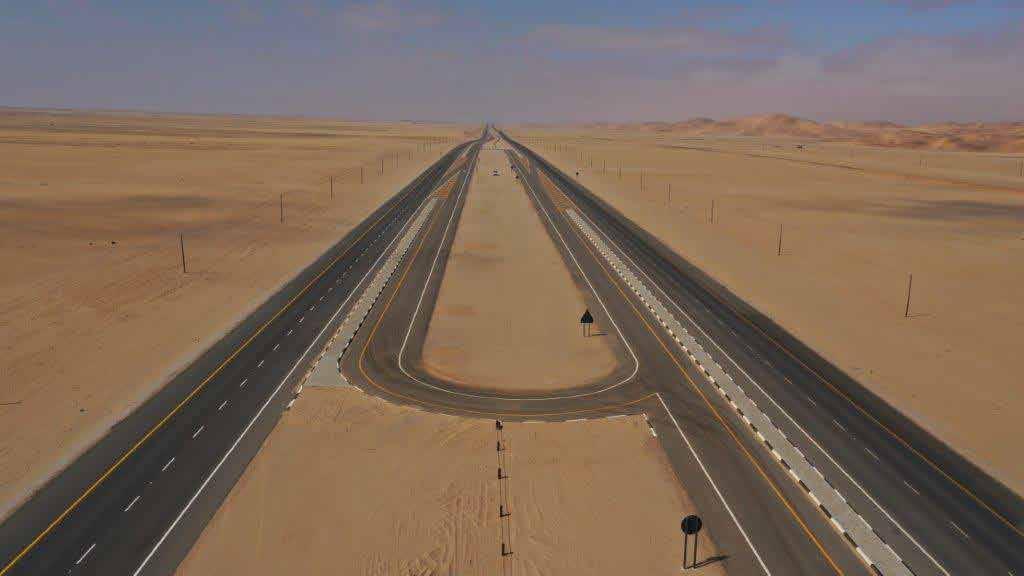
The Finance and Administration department is responsible for planning, implementing, managing and controlling all financial related activities of the company.

In addition, the department’s other functions include human resources, company secretarial and administration.
As per the 2021-2026 organisation strategic plan, the finance department’s strategic goal is the organisation financial sustainability, which is executed through the three initiatives: source alternative funding for WBNLDC permanent secretariat, revised membership fee structure & User Pay Principle (UPP) and adequate funding for all projects.
During the past twelve months we have:
• Engaged funding institutions for funding opportunities for WBNLDC secretariat;
• Initiated the discussions about the revision of the UPP rates;
• Secured new projects funding from GIZ, SADC, Engen Namibia and UNAIDS, as well as extension of current project agreements.
Sustainability remains a challenge, therefore, management make it a priority that we fully implement the above initiatives within the anticipated timelines. The transport and logistics sector has been negatively affected by the global

economic challenges. This has on only impacted WBCG but our members as well, and therefore some were unable to commit to the membership fee. Trade along the corridors have declined and thus, we were not able to reach the budgeted UPP.
To ensure operation continue despite decline in revenue; we kept to our strategy of cashflow management, by ensuring various cost saving mechanisms were implemented with regards to operational activities and overheads.
Promotion and Business Development activities have been revised to ensure maximum implementation in areas with highest return probability, this include minimizing exhibitions and conferences and focusing more on direct market engagements.
The department has an important role in coordinating the funding of the various projects between relevant donors and internal support functions. On-going communication and follow-ups between these parties have ensured that the WBCG remains a strong partner to the relevant development institutions.
The WBCG’s strict adherence to corporate governance, donor policies, donors reporting, transparency and accountability has allowed us to consistently ensure that we can utilise opportunities in the form of new and continuous project funding from relevant donors.
Our strength lies within the consistent improvement and delivery of our various projects which leads us to new opportunities within the national, regional and international markets.
To retain current donors and attract new ones, we ensure we deliver excellent service as per the workplans and reach desired targets. With the support of the Projects and Funding portfolio, the development of long-term funding remains a priority to provide for the gaps in WBCG activities.
WBCG operates in a highly competitive working environment and our competitive positioning in the market is derived from our employees’ quality of work and professionalism.
The human resource focused on the following key initiatives: enhanced service delivery, implement employee value proposition, identity critical capacity gaps to ensure a talent pipeline fit for the future
global WBCG, and close succession gaps.
During the past twelve months we have:
• Embarked on an employee’s “high performance culture” programme;
• With our recruitment we strive to attract competent human capital with the necessary potential, competencies and attitude to fill the manpower needs of the organization in achieving its objectives;
• A strong emphasis has been placed on capacity building through training, developing leadership and management skills, exposure and consistent improvement are the main factors that keep human resources at the WBCG;
Our wellness division provides wellness services to truckdrivers and to various vulnerable communities along our transport corridors. In the course of their work employees are constantly exposed to a complex variety of health and safety hazards. As an organisation the health of our employees is important. We strongly emphasis on compliance to our employee wellness policy, donors’ health guidelines and those of MOHSS.
The unqualified audit reports, continuation of our projects and operations are a clear testimony of our successes and the confidence which our donors, members and stakeholders have in the WBCG. With the support of the Projects and Funding portfolio, the development of long-term funding remains a priority to provide for the gaps in WBCG activities.
The Project Development and Funding Department of the Walvis Bay Corridor Group was established with a portfolio function to assist with the project preparation and to mobilize funding for priority projects of the WBCG and members.
These projects consist of infrastructural requirements for long-term and soft development, as well as trade facilitation, wellness services, and in turn support projects which ensure sufficient capacity for growth in the corridors.
Owing to the funding secured from the National Road Safety Council (NRSC), the WBCG and Trans Kalahari Corridor Secretariat (TKCS), in collaboration with the Ministry of Works and Transport (MWT), jointly commissioned and rolled out the “Thank a Trucker Campaign”, in designated towns along the Walvis Bay Corridors. The said Campaign was done in close collaboration with regional police and local authorities in Gobabis, Walvis Bay, Keetmanshoop, Rundu, Katima Mulilo and Oshikango. This Campaign was also extended to Botswana and South Africa, along the Trans Kalahari Corridor (TKC). Due to the success of the Campaign, Botswana resolved to replicate it in other towns in Botswana.
The technical support secured from GIZ and the Federal State of Bremen to TransNamib and Namport was successfully concluded in November 2021. The said support culminated in boosting TransNamib to improve its balance sheet for submitting a loan application to the Development Bank of Southern Africa (DBSA) and Development Bank of Namibia (DBN), to procure new rail rolling stock and modernize its maintenance workshops throughout Namibia.

Following a competitive bidding process, the Gobabis Municipality appointed Trans Kalahari Container Terminal to establish a truck stop and related amenities in Gobabis. The project site is opposite the Roads Authority weighbridge facility and will developed in two phases. The project owners secured the environmental clearance certificate and already completed bush clearing on site.
To this end only the ministerial authorization from the Ministry of Urban and Rural Development (MURD) as well as the fuel retail license from the Ministry of Mines and Energy (MME) is still pending in order for the project construction to start. Funding for the project has already been secured from private equity funders in Namibia and abroad.
Mount Meru Oil has a binding agreement with the project owners to be the preferred fuel suppliers and the existing fuel facilities in Gobabis will be relocated to the project site once the fuel retail license is secured from MME.
Pursuant to a site visit to Okondjatu, the project owners secured the land from the Otjozondjupa Regional Council, through the Okondjatu Settlement Office, to develop a truck stop and related facilities in Okondjatu. Mount Meru Oil has undertaken to be the preferred supplier for the said truck stop.
Plans are well underway, once negotiations are concluded between Mount Meru Oil, the project owners and another existing fuel service station owner, to develop the facility in the new financial year.
Following industrial land in Katima Mulilo that was secured from the Ministry of Industrialization and Trade (MIT), it has been resolved to draft a lease agreement between MIT and WBCG, to facilitate the Expression of Interest (EoI), to invite private sector, to develop the truck stop and related facilities in Katima Mulilo. The said draft lease agreement is currently with the Office of the Attorney General (AG) for legal scrutiny and clearance. WBCG and MIT plan to launch the EoI during the new financial year, once the draft lease agreement is cleared by the AG and signed between the two parties.
In order to ensure conducive movement of transit cargo through the port of Walvis Bay and to mitigate congestion, the Walvis Bay Municipality decided to roll out a short-term and long-term solution for truck stop developments in Walvis Bay. The Walvis Bay Municipality, with support
from WBCG, engagement Namport, TransNamib, Walvis Bay Port Users Association, Container Lines Operators Forum and the industry at large on how best to develop the said truck stop. Land has been identified to develop a temporary truck stop with private sector collaboration, which would be invited through an EoI. Walvis Bay Municipality is planning to launch the EoI during the next financial year.
WBCG secured funding to the tune of 100,000 Euros from GIZ Namibia, as part of their exit strategy from the transport and logistics industry, that enabled WBCG to carry out Wellness activities at designates sites in Namibia. The funding was also used to carry out activities at all the borders and seaports to improve trade facilitation measures that have a bearing on the successful implementation of the Logistics Hub Master Plan.
WBCG continued to engage the French Development Agency (AFD), the African Development Bank (AfDB) and other development partners to provide funding for feasibility studies to further develop the concepts on green logistics and the fourth industrial revolution.
Despite resources that are spread rather thinly on the ground, the department continues to redouble its efforts in exploring more funding opportunities to fill gaps in the infrastructure development, trade facilitation, wellness services and capacity development areas.






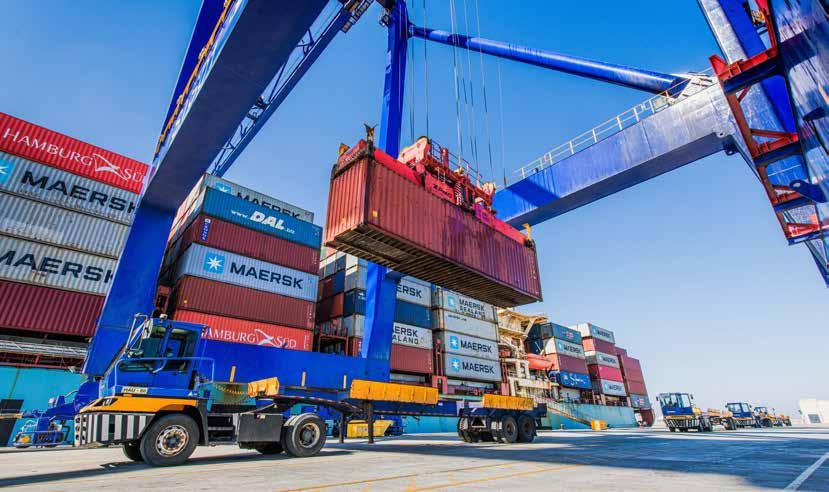
The Walvis Bay Ndola Lubumbashi Development Corridor Management Committee (WBLDCMC) proactively engaged relevant stakeholders to find urgent solutions to the challenges caused by the outbreak of the coronavirus pandemic two years ago which negatively impacted the global economy, regional
and international supply chains, as well as the cross-border movement of goods and services. WBCG’s Consultant on the WBNLDCMC, Mr. Eric Shimumbwe, highlighted the need for harmonized and simplified cross border laws and procedures between relevant authorities in Zambia, Namibia and the Democratic Republic of Congo (DRC) order for this proposal to gain traction and yield positive results.

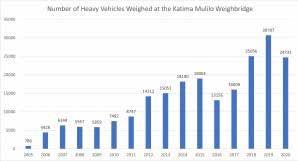
The Walvis Bay-Ndola-Lubumbashi Development Corridor (WBNLDC) remains the busiest in Namibia, as it continues to attract and carry the largest volumes of transit cargo between the port of Walvis Bay and the hinterland countries such as Zambia, Democratic Republic of Congo (DRC), Zimbabwe and Malawi.
The ‘Thank a Trucker’ campaign was launched on the 20th of May 2021 at the Katima Mulilo Weighbridge. The road safety campaign organised by the Walvis Bay Corridor Group (WBCG) and the Trans Kalahari Corridor Secretariat (TKCS), is sponsored by the NRSC. The campaign is aimed at raising awareness of road safety amongst truckers, their importance of keeping the economy moving andto appreciate the truck drivers as frontline heroes during the pandemic.


Mr. Sydney Chibbabbuka, Commissioner Customs Services, Zambia Revenue Authority (ZRA) speaking at second Zambia/ Namibia Bilateral Technical Committee meeting for the establishment of Katima Mulilo’s One Stop Border Post (OSBP),
which was held in Katima Mulilo, on 14 – 16 June 2021 stated that Zambia and Namibia have agreed to expedite discussions on the establishment of the One Stop Border Post because of the trade benefits that will accrue to the two countries and the region at large. The OSBP concept seeks to remove trade facilitation bottlenecks by ensuring efficient and timely movement of people, goods and services at borders.
The Ministry of Works and Transport in collaboration with the SADC-TTTFP, the Trans Kalahari Corridor Secretariat (TKCS) and WBCG, virtually engaged with stakeholders on the implementation of the
Corridor Trip Monitoring System (CTMS) to be piloted on the Trans Kalahari Corridor and the Walvis Bay-Ndola-Lubumbashi Development Corridor (WBNLDC) on 29 July 2021. The CTMS seeks to facilitate the continuation of cross-border trade of goods and services during the ongoing crises occasioned by the coronavirus.

The Walvis Bay Corridor Group (WBCG) in collaboration with the Ministry of Health and Social Services (MoHSS) and the Namibia Institute of Pathology, was approved by the Namibia Medicines Regulatory Council to roll out Covid-19 Antigen testing at all its clinics around the country. The outbreak of the Covid-19 pandemic had a direct impact on WBCG’s usual service offering, and the group resolved to integrate Covid-19 testing into its core wellness service activities in order to provide a comprehensive and relevant service.
Walvis Bay Corridor Group (WBCG), in collaboration with the Ministry of Health and Social Services intensified its community health programmes due to several people who died from the novel coronavirus were
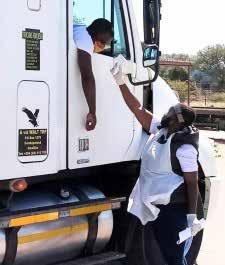
reported to have underlying ailments. Community members of Kuisebmond at the town of Walvis Bay flocked to the WBCG mobile clinic at Ekutu market for a general health check-up. The one-day free community health initiative included HIV testing.

WBCG’s Wellness Service received six (6) Oxygen Concentrators from Engen Namibia and emergency medical kits for the truckers from National United Security and Fire. The items were received

on September 2021 and will be used to support both the WBCG front line health workers and truck drivers who are in need of medical services. The Managing Director of Engen Namibia, Mr. Christian Li applauded the WBCG for their great initiatives and efforts in providing wellness services to the frontline truck drivers.
The Walvis Bay Corridor Group (WBCG) Wellness Service recently partnered with the Ministry of Health and Social Services (MoHSS) and Roads Authority to ensure that our corridor heroes, the truck drivers, have access to Covid-19 vaccines. The drive-thru vaccination centre was officially launched in September 2021 at the Roads Authority Weighbridge in Brakwater, Windhoek.

From August - November 2021, the WBCG and TKCS engaged over 380 truck drivers at designated roadblocks in Katima Mulilo, Rundu, Gobabis, Swakopmund, Oshikango and Keetmanshoop, as part of the ‘Thank
a Trucker’ campaign. The activities at the said roadblocks were held in conjunction with the Ministry of Works and Transport, Regional and Local Authorities, the Namibian Police, Roads Authority, Engen, Namport, MVA and RFA.


Honourable David Musabayane, Zimbabwe’s Deputy Minister of Foreign Affairs and International Trade emphasized in his statement at the WBCG’s information sharing session held in Harare on 12 October 2021, There is greater scope for both private and public sector involvement. The trade mission which started on 9 October 2021 was headed by the Ambassador of Namibia in Zimbabwe alongside the Ambassador of Zimbabwe in Namibia. The
trip was facilitated by the Walvis Bay Corridor Group (WBCG) in close collaboration with the Ministry of Works and Transport and the Namibian Ports Authority (Namport). The objective of the trade mission was twofold; strengthen the government bilateral relations and engage the Zimbabwean business community, captains of industry and economic sectors to explore business opportunities, prospects and the viability of optimum utilisation of the Port of Walvis Bay and the Zimbabwean Dry Port facility for Zimbabwean imports and exports.
The WBCG recently partnered with the Ministry of Health and Social Services (MoHSS), Deutsche Gesellschaft für Internationale Zusammenarbeit (GIZ) and
Engen Namibia to ensure that truck drivers have access to comprehensive health and wellness services along the Trans Oranje Corridor.The official launch of WBCG’s Roadside Wellness Clinic at the Engen 1 Stop Service Station in Keetmanshoop kicked off on 3 December 2021
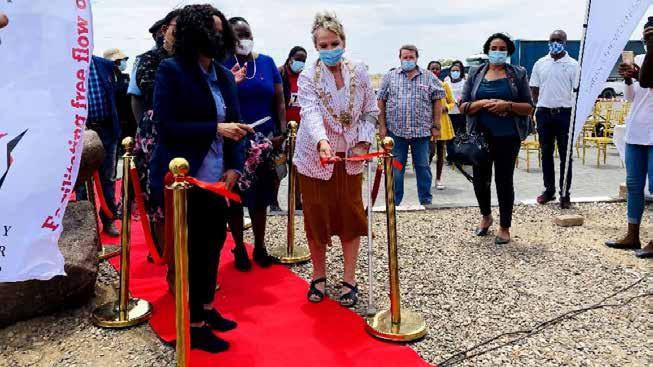
Barriers (NTBs) at the borders. WBCG’s has been advocating for a change in Covid-19 regulations to reduce congestion and other NTBs, as a result of Covid-19 protocols at the various border posts in Namibia.
The Walvis Bay Corridor Group (WBCG) plays a crucial role in improving trade facilitation in the SADC region and encouraging economic growth by advocating for the removal of Non-Tarrif
On the 13th January 2022 Ministry of Health and Social Services (MoHSS) of Namibia announced that the regulatory adjustments which were as follows as outlined outlined in number 14.11 (Requirements)
WALVIS
(WBCG) COMMENDS NAMIBIA FOR BECOMING THE FIRST COUNTRY IN SADC TO MAKE HEADWAY IN COVID-19 REGULATIONS FOR FULLY VACCINATED
A Zimbabwean business delegation recently visited Namibia to enhance business linkages and explore opportunities in imports and exports between the two countries as well as the storage of products at the Zimbabwe Dry Port. The main objective of the visit is exploring the port of Walvis Bay and the Walvis Bay Corridors as
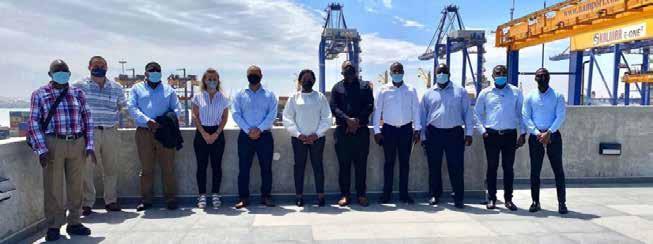
an alternative trade route. The delegation which consists of Executives from BAK Logistics, conducted business to business (B2B) meetings, toured the Zimbabwe Dry Port as well as the Port of Walvis Bay and its facilities. BAK Logistics is one of the largest logistics service providers in Zimbabwe, and has various partnerships that enables it to have an international reach.

“The TKC is not only important to Botswana but to the region as it promotes intra –regional and international trade as well as allowing the movement of people for business and tourism,” said His Excellency Dr. Batlang Comma Serema, High
Commissioner of the Republic of Botswana to Namibia. The High Commissioner stated this at the WBCG and SeaRail Botswana Information sharing Session held in Gaborone on 10 February 2022. Speaking to a fully packed room, he shared that the Botswana High Commission’s mandate is to promote Botswana’s interest in Namibia including trade and investment.
The Democratic Republic of Congo (DRC) hosted the 12th Walvis Bay-NdolaLubumbashi Development Corridor (WBNLDC) Tripartite Meeting, which was attended by the Ministers of Transport, key government senior officials, technical experts as well as the private sector from

the member states of the Republics of Namibia, Zambia, and the Democratic Republic of Congo. Facilitated by the Walvis Bay Corridor Group (WBCG), the tripartite meeting aimed at reviewing progress in the implementation of the WBNLDC tripartite agreement, which was signed in 2010.

In our continued efforts to promote and market Namibia’s Logistics Hub to the international market, the WBCG in collaboration with the Namibian Ports Authority - Namport had Business to Business (B2B) engagements with potential and current customers in Dubai, UAE, from 21 – 25 March 2022. The team also had benchmarking engagements with the Jebel Ali Free Zone Authority (Jafza) and Dubai South to get an in-depth understanding
of their Free Zone developments and how best the concept can be replicated, in view of the impending Special Economic Zones (SEZ) legislation in Namibia.
Head Office: Windhoek, Namibia

T: +264 61 251 669
E: marketing@wbcg.com.na
350
São Paulo, Brazil
T: +55 11 99 488 681 E: ricardo@wbcg.com.br
Lubumbashi, DRC
Tel: +243 81 850 3241 E. bdm@wbcg.cd
Johannesburg, South Africa
Tel: +27 65 154 1906 E: bdm@wbcg.co.za
Lusaka, Zambia
T: +260 979 573 349
E: bdm@wbcgzm.com